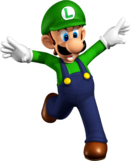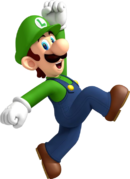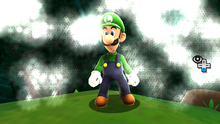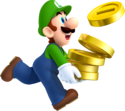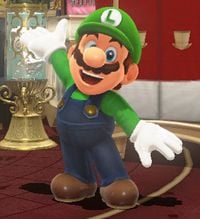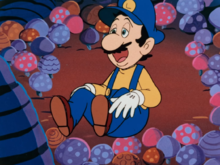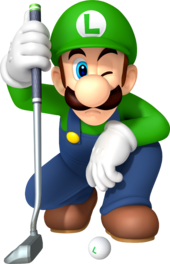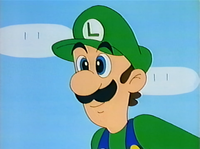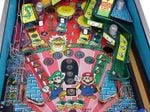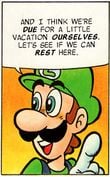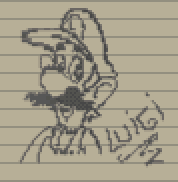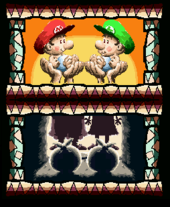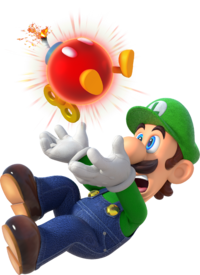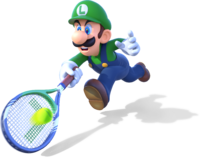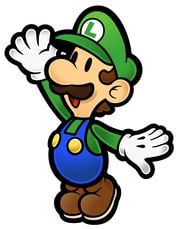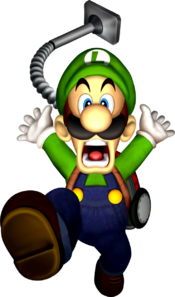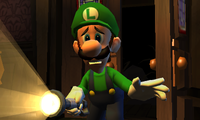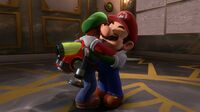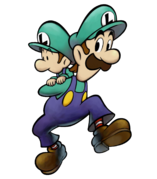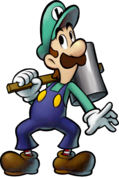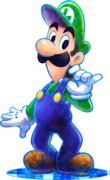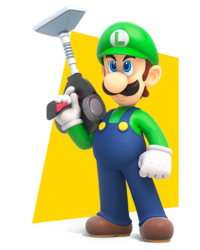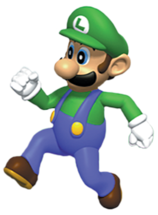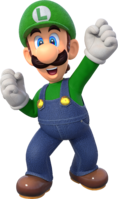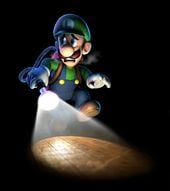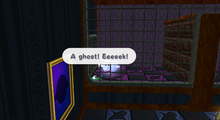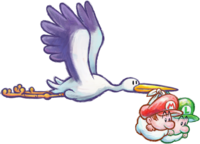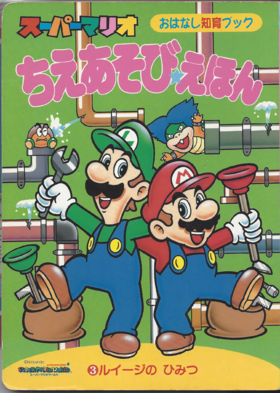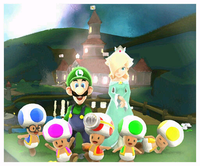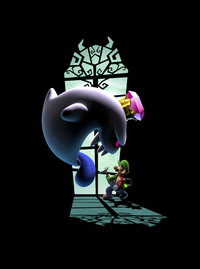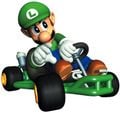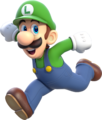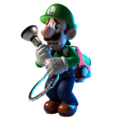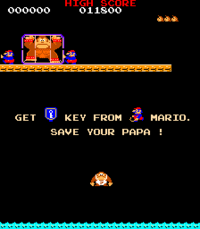Luigi
- This article is about Mario's younger brother from the Mario franchise. For the portrayal of Luigi in the Super Mario Bros. film, see Luigi (film character).
- “Eek! No one told me there would be gh-gh-ghosts here! I wish I'd brought my Poltergust 3000 with me.”
- —Luigi, Fortune Street
Luigi is Mario's slightly younger, taller fraternal twin brother and the deuteragonist of the Mario franchise. Throughout his life, he has lived in Mario's shadow, developing both cowardly and heroic tendencies. Despite this, Luigi has helped and fought alongside his brother on many occasions. Mario Bros. marks his first appearance in the Mario franchise and his debut in general. Originally an exact copy, then palette swap of Mario, Luigi was created to facilitate a second-player option. Since the two-player mode was dropped from most main Super Mario games beginning with Super Mario Land, Luigi has gained his own identity and personality, becoming a co-starring character of the Mario franchise. This is especially noticeable in installments for the Luigi's Mansion and the Mario & Luigi series of games. Luigi's notable traits include his green cap, his smooth mustache, his cowardly personality, his Italian accent, his heavy use of power-ups, and a superior jumping ability to Mario.
Creation and development
Luigi was created when Shigeru Miyamoto set out to create Mario Bros.[1] after being told that Mario resembled a plumber, a notion he wanted to officially establish.[2] After observing the two-player competitive and cooperative gameplay of the arcade game Joust, Miyamoto wished to incorporate a similar style of gameplay into his own game.[2][3] Miyamoto's answer to Joust's stork-riding player 2 was Luigi, a younger twin brother to Mario, with whom he could compete or cooperate. While Mario's name was based on Mario Segale, Luigi's name is said to have been based on a popular pizzeria near Nintendo of America's headquarters, named Mario & Luigi's[4]; coincidentally, his name was also noted to be similar to the Japanese word 「類似」 (ruiji), meaning "similar"[5], possibly a reference to how Luigi was originally a simple palette swap of Mario. With the 2-player mode in mind, Nintendo and publishing companies such as Atari gave Luigi immediate publicity, making him the star and center of attention in many advertisements for the game.[6][7]
Since his debut in 1983, Luigi has been constantly developing. Gameplay differences between him and Mario were first seen in Super Mario Bros.: The Lost Levels, which have been carried over into future games and have become standard for the character. After spending years as a palette swap of his brother, Luigi has consistently been given his own graphics since Super Mario Kart in 1992 to match his official appearance as Mario's taller, younger brother; though the American release of Super Mario Bros. 2 portrayed him in this way six years earlier. As he developed, Luigi gained more of a personality; it was as early as the DiC cartoons that Luigi was shown to be the more cautious of the two brothers, though it was not until Luigi's Mansion that this was truly and officially established.
In 2013, Luigi was the focus of the Year of Luigi, where in Nintendo released a number of themed games and merchandise and held events to honor the thirtieth anniversary of Luigi's first appearance in Mario Bros.
History
Mario Bros. (Game & Watch)
Luigi first appeared in Mario Bros. for the Game & Watch, where he loads cases of bottles in a bottling plant[8] onto trucks with Mario. Luigi is placed on the left,[9] while Mario is on the right. Luigi is the one who loads the truck, as well. Other than position, Luigi is identical to Mario in this game.
Mario Bros. (arcade)
Luigi next appears in Mario Bros., where he is simply a palette swap of Mario, having the same actions and abilities as Mario. This appearance is often incorrectly attributed as his first. Aside from his green and black color scheme, there are no other differences in physical appearance. In the game, Luigi and Mario are portrayed as plumbers, who are trying to rid the sewers where they are working from Shellcreepers, Slipices, and many other monstrous creatures. In the remakes of this game, such as the one in Mario & Luigi: Superstar Saga, Luigi's color scheme changes to his current color scheme, which is based on the game, though his attributes remain unchanged. Luigi was played by an unknown actor in a live-action commercial for the Atari 2600 version of Mario Bros. The commercial portrays Luigi as a coward, though it is unknown if this had any influence on Luigi's current personality or not.
VS. Wrecking Crew / Wrecking Crew
Luigi is once again the second player in VS. Wrecking Crew and its successor, Wrecking Crew. Luigi's sprite is a palette swap of Mario's, having him dressed in bright red and having dark blue eyes and hair with a dark blue hammer, and paler skin than Mario's. Luigi has the same controls and role as Mario. However, in the former game's single-player mode, the computer-controlled Luigi will act as an opponent to Mario, reminiscent of Foreman Spike in the latter game.
Super Mario series
Super Mario Bros.
In Super Mario Bros., Luigi has the same jumping powers, same traction, and the same running speed as Mario. He is only playable in 2-player mode and is controlled by the second player only. Luigi's color scheme in this game shows him in a green shirt with white overalls and cap, along with having green hair and a green mustache, while remakes of the game show him in his modern colors established since Super Mario World.
Super Mario Bros.: The Lost Levels
Luigi also appears in the Japan-only sequel of Super Mario Bros., Super Mario Bros.: The Lost Levels, known as Super Mario Bros. 2 in Japan. For the first time, Luigi could now jump higher and further than Mario, though he has less traction, causing Luigi to slide slightly after moving. Instead of being strictly available only in 2-player mode, players could select him as their character in the single player adventure. His sprites from this game are reused from Super Mario Bros.
Super Mario Bros. 2
In the Western Super Mario Bros. 2, Luigi is one of four playable characters, where, like in The Lost Levels, he could jump higher than anyone else, though he is the second weakest in the group behind Princess Toadstool. This is the first game where Luigi isn't a recolor of Mario's sprite; instead, he is portrayed as taller than his brother. As Super Mario Bros. 2 was a Western version of the Japanese game Yume Kōjō: Doki Doki Panic, this was done so Luigi could fit the proportions of the character Mama.
Super Mario Bros. 3
In Super Mario Bros. 3, Luigi is once again a palette swap of Mario; none of the original skills he had in the versions of Super Mario Bros. 2 were carried over. Luigi has all of Mario's additional abilities, which includes carrying objects and the several power-up transformations, but his high jumps and low traction were removed. The only discernible differences are his green overalls and cap. Also, like in Super Mario Bros., Luigi can only be controlled by the second player in a 2-player game.
In the game's 16-bit remakes, Luigi is made taller than Mario (excluding his Statue form in Super Mario All-Stars). The GBA version also gives him his scuttle from Super Mario Bros. 2 and fireball physics from Super Mario World: Super Mario Advance 2 in World-e; these properties can also be applied to the main game by scanning the Yellow Switch card.
Super Mario World
Luigi appears in Super Mario World again as a palette swap of Mario, having his brother's abilities and properties, and can only be played by the second player in a 2-player game. While his appearance was updated in the SNES rerelease, Super Mario All-Stars + Super Mario World, his attributes stayed the same, though his actions differed from Mario's. In the GBA port, Super Mario World: Super Mario Advance 2, Luigi regained his high jump and low traction attributes and can be switched out with Mario during the single player adventure, while his appearance borrowed elements from his design in Super Mario Bros. 2.
Super Mario 64 DS
While he was originally supposed to appear in the final version of Super Mario 64,[10] Luigi appears in its remake, Super Mario 64 DS, instead as an unlockable character. Luigi was one of the characters to be invited to the Mushroom Castle, along with Mario and Wario. However, Bowser trapped everyone inside the castle walls and paintings, with Luigi and the other heroes being locked behind a door with the key to his door being guarded by King Boo. To unlock Luigi, Mario has to go to the top floor of Big Boo's Haunt and jump into the Luigi painting, which brings Mario to the Big Boo Battle course. Defeating King Boo rewards the player with the key needed to unlock Luigi. Once Luigi is unlocked, Luigi Caps can be found on every course after he has been rescued. The Luigi Cap allows the wearer to mimic Luigi's appearance, attributes, and abilities perfectly, save for his voice. Through standard means, Luigi is the only character who can save Wario from Chief Chilly's grasp, as he is the only character who can walk through the mirror in the Snowman's Land room by using his invisibility power to get to Wario's painting. While Luigi is needed to collect certain Power Stars, he is not required to complete the game.

While the instruction booklet for Super Mario 64 DS says that he has the greatest agility, Luigi's acceleration is actually lower than Mario's. He does, however, have higher top speed. He can also swim faster than the other characters. Luigi is also one of the best jumpers, along with Yoshi, and gives out the biggest distance by long-jumping. His attacks do the same amount of damage to enemies as Mario's, but he moves a little slower while carrying enemies and objects. If Luigi performs a backward somersault, he does a Spin Jump, like what happens when any of the characters jump on a Fly Guy or Spindrift. Luigi can additionally scuttle for a short period of time after any of his forward jumps, and he can run on water for a few seconds due to being lighter on his feet. Luigi's ability from a Power Flower is to turn invisible, similar to the invisible power Mario gets in the original game when wearing the Vanish Cap. This ability allows him to evade enemies and run through certain interfaces such as steel grates; however, Vanish Luigi cannot go through ice, unlike Vanish Mario.
All of Luigi's minigames from the Rec Room revolve around gambling games. Luigi acts as the dealer in all of the card games, and he does not wear his usual attire, instead wearing a white shirt with a black vest and a green bowtie.
New Super Mario Bros.
In New Super Mario Bros.'s main story, Luigi has the same role and controls as Mario. To play as Luigi, the player needs to hold down the ![]() and
and ![]() Buttons when selecting a file. If inputted correctly, Luigi's voice is then heard. While the code is revealed to the player after the credits roll, it can be used at any time.
Buttons when selecting a file. If inputted correctly, Luigi's voice is then heard. While the code is revealed to the player after the credits roll, it can be used at any time.
Luigi is also playable in the multiplayer mode, "Mario vs. Luigi." Here, he and Mario compete to see who can collect the most Big Stars. Like in the main game, Luigi's attributes and controls are the same as Mario's. The player who starts the mode has the option of choosing between Mario or Luigi to play as with the guest player taking the role of the other brother.
In the minigame mode, three of Luigi's minigames from Super Mario 64 DS return under the category "Table": Memory Match, Picture Poker, and Pair-a-Gone. Luigi's appearance and role in these minigames is the same as in Super Mario 64 DS. Luigi also appears in the Whack-a-Monty and Wanted! minigames.
Super Mario Galaxy
- “I knew I could rely on you, bro!”
- —Luigi, Super Mario Galaxy
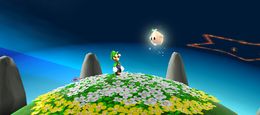
Luigi appears in Super Mario Galaxy, both as an NPC and as an unlockable character. When Bowser abducts Peach's Castle, Luigi and the Toad Brigade are apparently inside, though they all soon escape and end up getting lost in space. Luigi is found imprisoned in the Ghostly Galaxy as the goal of the first star. After rescuing him, Luigi goes out on his own in search of the Power Stars appearing in three different galaxies: the Good Egg Galaxy, the Honeyhive Galaxy, and the Battlerock Galaxy. Rescuing him in his respective missions rewards the player with a Power Star or, in the Battlerock Galaxy's case, a Green Star. When Luigi is not actively seeking Power Stars, he can be found in the Garage of the Comet Observatory.
After the player collects all 120 Power Stars and defeats Bowser again, the player has to play the entirety of the game again, this time as Luigi. Luigi has different attributes and controls differently than Mario: he runs faster, but takes longer to build speed and is harder for him to stop running, he can jump higher and farther, and the air meter depletes faster when spinning underwater. Cosmic Luigi is also faster and takes different routes than Cosmic Mario. Additionally, the names of the stars that have "Mario" in their title are changed to "Luigi".
While Luigi is the controlled character, the NPC Luigi in the game is not switched out, essentially having two Luigis in the game. While the playable Luigi is adjusted to fit Mario's build for gameplay purposes, the NPC Luigi is slightly taller and colored darker, matching Luigi's actual proportions. When the playable Luigi first rescues the trapped Luigi in the Ghostly Galaxy, the NPC Luigi dismisses the player as someone who happens to look like him. When the player rescues the NPC Luigi in three rescue missions, the NPC Luigi refers to the player as "me" (for example, "I knew I could rely on... me!"). When the NPC Luigi is in the Garage and the player talks to Rosalina, she refers to both Luigis as "twins". When the Mailtoad has mail, the letters are addressed to Mario as usual instead of Luigi, causing the Mailtoad to feel bad for Luigi. Additionally, some of the letters contains 20 1-Up Mushrooms instead of the usual 5.
New Super Mario Bros. Wii
- “Phew, made it.”
- —Luigi, New Super Mario Bros. Wii
Luigi appears in New Super Mario Bros. Wii as a main character, along with Mario, a Blue Toad, and a Yellow Toad. During any of the modes, player one is always Mario and players two through four can choose to be either Luigi or one of the Toads; however, Luigi is also playable in single-player mode, done by activating the Super Guide and pressing ![]() to take control of him. Luigi's and the Toad's properties are all the same as Mario's, meaning Luigi does not have his unique attributes like the higher jumps or low traction. Luigi is slightly taller than the other characters, however, making him easier to get by hit by enemies above him. In the ending, he arrives alongside the Blue and Yellow Toads in Hot Air Balloons and has Mario and a newly-rescued Princess Peach enter his hot air balloon. However, he accidentally locked himself out of his hot air balloon while distracted waving goodbye to the Toads, having it take off without him.
to take control of him. Luigi's and the Toad's properties are all the same as Mario's, meaning Luigi does not have his unique attributes like the higher jumps or low traction. Luigi is slightly taller than the other characters, however, making him easier to get by hit by enemies above him. In the ending, he arrives alongside the Blue and Yellow Toads in Hot Air Balloons and has Mario and a newly-rescued Princess Peach enter his hot air balloon. However, he accidentally locked himself out of his hot air balloon while distracted waving goodbye to the Toads, having it take off without him.
If the player(s) die enough times in a stage, a Super Guide Block appears. Hitting it activates the Super Guide where a computer-controlled Luigi plays through the stage for the player. This Luigi only attempts to get to the end of the stage, usually avoiding any secrets or unneeded power-ups.
Super Mario Galaxy 2
- “Hey, Bro! I'm all over the place these days, exploring the universe!”
- —Luigi, Super Mario Galaxy 2
Luigi appears in Super Mario Galaxy 2 where he is an unlockable playable character. His attributes and controls are retained from the first Super Mario Galaxy. After the player collects 30 Power Stars and completes Bowser's Big Lava Power Party, Luigi can be found at the beginning of some levels. If Mario talks to Luigi, he asks Mario if he can get the Power Star instead and accepting his offer lets the player control Luigi instead of Mario until the player completes or exits the current mission. Completing missions with Luigi unlocks staff ghosts for that current mission. The ghosts appear as Luigi and begin moving to a particular spot in the stage once the player touches them. If the player uses the Co-Star Luma to spin in front of Luigi when he appears in a galaxy, he releases several Star Bits.
Once the player completes Bowser's Galaxy Generator, they can alternate between using Mario or Luigi by way of entering the large door behind where the player starts on Starship Mario. The Mailtoad receives a letter from Luigi telling the player about the option, signifying when the option becomes available. Also, while the player is playing as Luigi, the Tip Network signs and the Cosmic Guide do not appear.
Super Mario 3D Land
- “Help me!”
- —Luigi, Super Mario 3D Land
In Super Mario 3D Land, Luigi is an unlockable character. To unlock Luigi, the player has to clear Special 1-Castle, in which Luigi becomes playable. To switch between Mario and Luigi, the player has to tap either the "M" or "L" icon (depending on which brother is currently being played as) on the bottom screen during the level select map screens.
In term of controls, Luigi controls much like how he does in Super Mario Bros.: The Lost Levels and Super Mario Galaxy: Luigi has a higher jump than Mario, but lower traction, causing him to slide. Luigi can use all of the same power-ups as Mario, though when collecting a Super Leaf, instead of turning into Tanooki Luigi like in Super Mario Bros. 3, he gains a suit that looks like a kitsune, which is a Japanese fox. Most other languages, including the Japanese version, as well as English versions of later games, call this form Kitsune Luigi.
New Super Mario Bros. 2
In New Super Mario Bros. 2, Luigi is an unlockable character in single-player mode and is the character for player 2 in Co-Op Mode. Like with the other New Super Mario Bros. series of games, Luigi's physics and controls are the same as Mario's. Luigi's Raccoon appearance appears similar to his Kitsune form from Super Mario 3D Land, taking on the ears and tail of the fox, and Luigi turns silver instead of gold when under the effects of the Gold Flower. Both forms are to differentiate him from Mario and both appearances are purely cosmetic; they do not affect the power-ups' properties at all.
Luigi is unlocked for the single-player mode after clearing World 6-Bowser's Castle. The code is the same as in New Super Mario Bros. ( +
).
New Super Mario Bros. U / New Super Mario Bros. U Deluxe
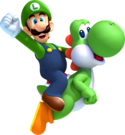
Luigi appears as a playable character in New Super Mario Bros. U and New Super Mario Bros. U Deluxe. Like with New Super Mario Bros. Wii, Luigi can usually only be controlled by players either two, three, or four as Mario is always player one, but he can also be playable in single-player mode by activating the Super Guide and pressing ![]() . However, Luigi can be controlled by player one in New Super Mario Bros. U Deluxe's main mode of New Super Mario Bros. U. To make it easier on the players, Luigi controls like the other characters, with him and the two playable Toads having the same controls and attributes as Mario.
. However, Luigi can be controlled by player one in New Super Mario Bros. U Deluxe's main mode of New Super Mario Bros. U. To make it easier on the players, Luigi controls like the other characters, with him and the two playable Toads having the same controls and attributes as Mario.
In the opening title sequence of the game, Luigi moves along with the other characters, though in some rare cases, Luigi ends up tripping instead, causing him to mess up his Ground Pound action.[11]
New Super Luigi U
To celebrate 2013 as the Year of Luigi, Luigi appears as the main playable character in the expansion of New Super Mario Bros. U titled New Super Luigi U, with Mario making no appearance at all in the expansion pack. In this game, Luigi is given his unique play style again; he jumps higher and farther than Mario, but has worse traction, as in other titles such as Super Mario Bros.: The Lost Levels. This makes New Super Luigi U the only title in the New Super Mario Bros. series where Luigi has his unique attributes, until New Super Mario Bros. U Deluxe. Consequently, the other characters jump higher as well.
New Super Luigi U, as part of 2013's Year of Luigi, includes Luigi sightings. These are images, statues, and 8-bit sprites of Luigi that are hidden in every level.
Super Mario 3D World
- “Oh yeah, Luigi! Go green!”
- —Luigi, Super Mario 3D World
Luigi returns in Super Mario 3D World as one of the default playable characters. As the game's cast is primarily based on Super Mario Bros. 2, Luigi retains his attributes from that game, being able to jump higher and farther, while having low traction. Unlike with the other titles with simultaneous multiplayer, Luigi can be selected by player one. The power-ups Luigi uses also change to his color scheme accordingly, such as the Boomerang Suit becoming green, and his Kitsune Luigi form returns when he gets a Super Leaf.
Luigi is also featured as the playable character in the game's "Luigi Bros." minigame, a game identical to Mario Bros., but replacing Mario with Luigi as the main playable character. Player one's Luigi is colored similarly to his modern appearance, whereas player two's Luigi has the colors from the original game. Both Luigi's have the same physics and controls, which are carried over from the original game.
Like in New Super Luigi U, Luigi sightings also appear in this game as part of the Year of Luigi. They are usually 8-bit sprites of Luigi and are hidden in most of the levels.
Super Mario Maker
- “Yeah!”
- —Luigi, Super Mario Maker
Luigi appears as an unlockable Mystery Mushroom costume in Super Mario Maker. The costume can be unlocked either at random upon completion of the 100 Mario Challenge, or by scanning a compatible Luigi amiibo. His appearance is based on that of Super Mario Bros., except with his modern colors. The costume replaces some of the usual Super Mario Bros. sounds with sounds from Luigi's Mansion. Fire Luigi in his Super Mario Bros. sprite (though with a green shirt rather than a red) also appears on the splash screen of the game on Sundays and shoots a fireball at Mario, knocking him off-screen.
Super Mario Run
Luigi reappears in Super Mario Run as a playable character along with Mario, Princess Peach, Toad, Toadette, and the colored Yoshis. Luigi is an unlockable character. To unlock his house, the player has to recruit 150 Green and Purple Toads each through Toad Rally, then spend 1000 coins to build the house. Luigi has his higher jump and scuttle in this game.[12] Along with Mario, Luigi has a small form, allowing him to be hit once before dying.
Super Mario Odyssey
Even though Luigi did not physically appear in Super Mario Odyssey originally, his cap and outfit are able to be purchased and worn by Mario in any of the Crazy Cap shops. The aforementioned outfit and cap are also unlockable via the Luigi amiibo or by completing the game with a certain number of moons.
Luigi himself was added as an NPC in the update released on February 21, 2018, where he hosts the new Balloon World minigame. He appears with a green polka dotted bow tie and a luggage hanging on his back with balloons attached to it, allowing him to float. On the luggage are various stickers from the Mushroom Kingdom and a sticker with his emblem on it. Luigi's dialogue changes depending on the clothes Mario is wearing upon talking to him.
As of March 14, 2018, Nintendo began posting extra Hint Art on social media leading to locations of hidden Luigi sprites. If Mario ground pounds on the exact spot as depicted in the Hint Art, a sprite of Luigi from Super Mario Bros. pops out of the ground (recolored to match his modern design, as seen in his Mystery Mushroom costume in Super Mario Maker) and grants him 200 coins the first time it is discovered. Upon emerging (or if ground pounded), it lets out a distorted cry, and if Mario throws Cappy at it, it spins into the air.
The way Luigi and his red, blue, and yellow balloons are positioned corresponds to the layout of the ,
,
and
buttons on the Japanese and PAL versions of the SNES Controller when viewed sideways.
Depending on what Mario is wearing when talking to him, Luigi will comment on it:
- Black Tuxedo / Explorer Outfit / Builder Outfit / Golf Outfit / Chef Suit / Painter Outfit / Mario 64 Suit / Mechanic Outfit / Classic Suit / Doctor Outfit / Waluigi Suit / Diddy Kong Suit / Wario Suit / Metal Mario Suit / Sunshine Outfit / Topper Suit / Rango Suit / Hariet Suit / Spewart Suit: "Hey... Have I seen that outfit somewhere before...? Anyway, lookin' good, Bro!"
- Boxer Shorts / Clown Outfit / Skeleton Suit / Gold Mario Suit / Zombie Outfit / 8-Bit Mario Cap: "Bro! You startled me! That outfit is kinda, ummm... How can I put this? I mean, it looks good on you! It looks good, but uhh... Yeah..."
- Luigi Suit: "Huh? What? Another... me?! No, wait. Is that you, Bro? Whoa, you really threw me for a loop there!"
- Bowser's Tuxedo / Bridal Gown / Mario's Tuxedo: "Whoa, Bro, you're getting married?! AND YOU DIDN'T TELL ME?! Oh, you're just wearing the outfit? For, like, fun? Huh."
- Invisibility Hat: "Bro, are you there?! I can't see you! You're scaring me! ...Are you still there? I'm just going to keep talking..."
Super Mario Maker 2
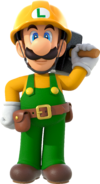
Luigi appears in Super Mario Maker 2 as a playable character. Luigi is given a builder outfit of his own, which is identical to Mario's but with dark green overalls. Luigi also appears in the game's Story Mode when the player fails a course twice and he offers to either complete the course for them, or parts to make the stage easier.
He also appears in two of the opening sequences. In the first opening, Mario, Toad, and Toadette walk towards the game's logo, notice the number "2" is missing, and when they hit it together, Luigi falls (with the number "2" landing on the logo) and they proceed to leave. In the second opening as of the version 1.1.0 update, Luigi is seen with a Key; once he arrives at the Key Door, Mario, Toad, and Toadette are there next to it and slowly approach Luigi, who then runs away with the Key, causing the three to chase him and take the Key by force off-screen. Afterwards Mario collects the Key and opens the Key Door, they proceed inside, and as the Key Door shuts, the number "2" falls on the logo.
Luigi's Super Mario Bros. Small form sprite may also appear if a Warp Door is knocked in the Super Mario 3D World style, akin to that game's Luigi sightings.
Super Mario Bros.: Peach-hime Kyushutsu Dai Sakusen!
The first animated Luigi appears in the anime movie Super Mario Bros.: Peach-hime Kyushutsu Dai Sakusen!, where he was voiced by Yuu Mizushima. His color scheme in the movie is different from the games, as he is wearing a blue cap and overalls with a yellow shirt (and a red shirt in the promotional artwork for the anime), although it may be worth noting that, at the time of Peach-hime Kyushutsu Dai Sakusen!'s creation, Luigi had not yet been given a consistent palette and his current color scheme had not been introduced in-game. The anime also marked the first time Luigi was ever given a personality; Peach-hime Kyushutsu Dai Sakusen! depicted Luigi as very greedy, typically thinking only of profits and characterized by his pick-axe and shovel, both of which he used to mine for Coins. (As a matter of fact, Luigi often left adventuring with Mario and Kibidango to search for Coins, though he usually ended up helping them progress in various ways through his miserly efforts.) Luigi in the anime was also noticeably more serious and less dreamy than Mario, and he seemed to lack his brother's almost otherworldly connection to Princess Peach.
Mario Golf series
- “Oh dear... I've practiced, but nobody play with Luigi. Will you play with me?”
- —Luigi, Mario Golf: Toadstool Tour
Luigi has appeared in every game of the Mario Golf series. His first appearance was in Family Computer Golf: Japan Course, followed by Family Computer Golf: U.S. Course and NES Open Tournament Golf. In the latter two games, Luigi wears green and white striped overalls and cap along with a blue shirt with white stars imprinted on it, and are the only games to show Luigi in this outfit. Gameplay-wise, there are no differences between him and Mario.
Luigi reappeared in Mario Golf as a default character in the Nintendo 64 version and an unlockable character in the Game Boy Color version. He is one of the first characters that can be unlocked in the Game Boy Color version by beating him on the "Get Character Mode". He had a unique course (in the sense that it was the only course in the game set up like a mini-golf course) named Luigi's Garden. At his strongest, Luigi can hit the golf ball up 220 yards and his shot type is "Fade".
He made his fourth Mario Golf appearance in Mario Golf: Toadstool Tour as a default character. In this game he has a fade with low trajectory and can hit 207 yards, or 240 when he's a starred character.
Although Luigi is not a default character in Mario Golf: Advance Tour, he is unlockable by linking the game with Mario Golf: Toadstool Tour. His stats are about the same as in Toadstool Tour, hitting 206 yards instead of 207.
Luigi is a default playable character in Mario Golf: World Tour. Yet again, he has a low shot with a fade. His star rank is obtained when the player completes a match challenge in Cheep Cheep Lagoon, and his costume is unlocked by earning 50 scorecard badges on Castle Club courses.
DIC cartoons
Luigi appeared in all ninety-one episodes of the three cartoon series produced by DIC Entertainment, though Mario only appeared in ninety episodes. In these cartoons, he was given green eyes instead of the usual blue that he has in the games. Luigi is the only character to appear in every episode of the DIC Mario cartoons.
The Super Mario Bros. Super Show!
- “Me? B-b-but I can't swim across the moat! I'm, uh, gonna have a baby!”
- —Luigi, The Super Mario Bros. Super Show!
In the television series The Super Mario Bros. Super Show!, Luigi, portrayed by Danny Wells, is seen living in Brooklyn together with Mario in the live-action segments. Like his brother, Luigi works as a plumber, running Mario Brothers Plumbing together with him. The episode Plummers Academy shows that he graduated from the Brooklyn Plumbers Academy together with Mario. The live-action segments show the two as having gained a reputation for their plumbing skills, even being awarded the title Plumbers of the Year in the segment of the same name. In the cartoon segments of the show, Luigi regularly joins his brother in various adventures in the Mushroom Kingdom. In the cartoon segments, Luigi is depicted as cowardly and overly cautious, a trait he later shows in the Luigi's Mansion and Mario & Luigi games.
The Adventures of Super Mario Bros. 3
- “How can we help America when we can't even help ourselves? They've got us triple-guarded!”
- —Luigi, The Adventures of Super Mario Bros. 3
Luigi is played by Tony Rosato in the two cartoon follow-ups to the Super Show: The Adventures of Super Mario Bros. 3 and Super Mario World. The former is almost exactly like the Super Show, except the Koopa Kids join their father in making trouble for Luigi and the others. Once again, Luigi is depicted as a cautious and timid character; easily startled and reluctant to do anything dangerous, unless it means saving others.
In the episode "The Beauty of Kootie," Casanova Koopa is what Luigi turned into to trick Kootie Pie into letting Toad, Toadstool, and the King of Desert Land free. Kootie tricked Mario by having her brother Cheatsy change her into a human so she could flirt with him and distract him in order to carry out their plan. After the trick was revealed and the Mario Brothers got away, Mario used a swiped Magic Wand to transform Luigi into Kootie's "dream reptile" as a distraction. The trick worked for awhile, but after Casanova Koopa tricked Kootie Pie into releasing the prisoners and Kootie started kissing him, she accidentally activated her wand. Subsequently, Luigi was reverted into his true state, which made Kootie Pie scream and chase him with Cheatsy behind her.
Super Mario World
- “It's all right! He wants to shake hands! He wants to be friends!!”
- —Luigi, Super Mario World (television series)
The Super Mario World television series shifts the setting from the Mushroom Kingdom to Dinosaur World, but once again, it is relatively the same as the earlier cartoons, with Mario, Luigi, and Princess Toadstool stopping the evil plots of King Koopa and his Koopa Kids. However, the heroes are now aided by the dinosaur Yoshi (replacing Toad), who was actually discovered by Luigi, who found an egg after falling down a waterfall. When he hatched, Yoshi affectionately called Luigi Mama Luigi.
Amada Anime Series: Super Mario Bros.
Luigi also appears in another anime, called the Amada Anime Series: Super Mario Bros., where he is depicted as wearing his traditional blue overalls and green shirt. Luigi only appears in the last story of the Super Mario anime series film, Shirayuki-hime appearing just in time to save Mario and Princess Peach from King Koopa.
Super Mario World: Mario to Yoshi no Bōken Land
Luigi is a main character in the interactive OVA Super Mario World: Mario to Yoshi no Bōken Land. He is part of a group trying to rescue Princess Peach from King Koopa. His appearance is notable for being one of the earliest examples of his cowardly personality - preceded by his appearances in ths DIC Mario cartoons - depicting him and Yoshi initially being too scared to enter a Ghost House. He also gets easily angered when Mario triggers an explosion when Luigi is in blasting range, and everyone laughs at him, causing him to abandon the mission. However, he eventually overcomes this through his love for his brother and Princess Peach, and comes to the rescue when Mario is having trouble fighting King Koopa.
Super Mario Bros. pinball machine
Luigi appears in the Super Mario Bros. pinball machine on the front artwork, where he is depicted to be held captive in the world six Castle by Wart, despite the fact that Luigi is never held captive in Super Mario World (the game on which the machine is based) and Wart never appears in said game at all. He also appears in the playfield next to Caped Mario and between two bumpers.
Mario Kart series
- “Oh yeah, can't stop Luigi!”
- —Luigi, Mario Kart 8
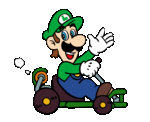

Luigi has appeared in every Mario Kart game to date. Throughout all his appearances, he is classified as a medium weight, making him a balanced racer, like Mario.
In Super Mario Kart, a computer-controlled Luigi often uses Super Stars as his item of choice. In Mario Kart 64, Luigi gains a course of his own called Luigi Raceway, which is the first race of the Mushroom Cup and, consequently, the first race of the game. Luigi also has a race course in Mario Kart: Super Circuit's Lightning Cup. Notably, Luigi uses his Mario Kart 64 Japanese voice-overs in all versions of Super Circuit.
In Mario Kart: Double Dash!!, Luigi has a special item, the Green Fireball, as well as an unlockable personal kart, the Green Fire. Mario is his default partner. As in Mario Kart 64, the first course in the game is Luigi Circuit, but Luigi also has a battle course, which is his haunted mansion. Baby Luigi also makes his debut playable appearance in the Mario Kart series here.
Luigi's personal karts in Mario Kart DS are the Poltergust 4000, the Streamliner, and the Standard LG. Luigi's karts each offer all-around stats for the speed, acceleration, and handling categories, but with poor drifting abilities. A race course based on his mansion reappears as a course in the Mushroom Cup, as well as the Luigi Circuits from Mario Kart: Super Circuit and Mario Kart: Double Dash!! in the Leaf Cup and Shell Cup respectively.
Luigi in Mario Kart Wii can use a variety of karts and bikes, although there are no personal karts. The only course based on Luigi in this game is Luigi Circuit, the first course of the Mushroom Cup. Luigi adds a small speed boost to his karts, but his best bonus is the weight stat.
In Mario Kart 7, Luigi is once again a middleweight racer with relatively balanced stats. Luigi Raceway from Mario Kart 64 and Luigi's Mansion from Mario Kart DS return as the first and last races of the Shell Cup respectively.
Luigi returns in Mario Kart 8 as a playable character, though he does not have any courses based on him in this game. This is the first game in the main series since Super Mario Kart to not feature a course of any kind based on Luigi. Luigi also has a racing team in this game called Luigi Gusters. Luigi reprises his role in the game's enhanced port, Mario Kart 8 Deluxe. Luigi's Mansion from Mario Kart: Double Dash!! also returns as a retro battle course in Mario Kart 8 Deluxe.
He reappears in a playable role yet again in Mario Kart Tour, where he was made available since the Halloween Tour as a Super character; like his brother and Metal Mario, the Fire Flower reappears as Luigi's special item. As of January 14, 2020 (PST), Luigi wearing the Penguin Suit (known as Penguin Luigi in-game) is a separate playable character in Mario Kart Tour, being the second High-End Spotlight driver of the Ice Tour and having the Ice Flower as his special item. In addition, Luigi also has another separate character for the Mario Bros. Tour based on his classic look from Super Mario Bros.: The Lost Levels and Super Mario Bros. 2 (appropriately named Luigi (Classic)) which utilizes the Lucky Seven as his special item instead. Additionally, during the aforementioned tour, both Mario and Luigi were also made available as the first two Super Spotlight drivers alongside their respective alternate forms for the first and second weeks of the tour.
Luigi also appears in the Mario Kart games for the arcade, Mario Kart Arcade GP, Mario Kart Arcade GP 2, and Mario Kart Arcade GP DX. His and Mario's special character items are the Super Star, Fireball, Hammer, and Chain Chomp. In Mario Kart Arcade GP 2, his personal kart is a train-like vehicle while in Mario Kart Arcade GP DX, his personal kart is the Vacuum Star. Luigi has also an alternate color which resembles Ice Luigi.
Super Mario Adventures
The Super Mario Adventures comic serial's depiction of Luigi features him in an similar portrayal to his personality in the games and cartoons, however, he is often hungry and wanting to eat. In the first installment, Luigi wants to eat his lunch before working on repairing the Princess's horribly mangled plumbing, whining about his hunger as he grows frustrated with the job, while Mario cheerfully reconnects the pipes. He gets very upset when Mario is bitten and falls onto his lunchbox, and as more pipes pop up around the brothers, Luigi wants to grab the remains of his lunch, but Mario drags him out of the castle. Interestingly, Luigi is actually enticed by a Ghost House that Bowser has set as a trap for them, wanting to spend the night in it, while Mario tries to warn him that it is a trap. Luigi rushes inside when Bowser lets loose the scent of a giant hunk of aged provolone cheese, and starts eating it, oblivious to the Boos coming up behind him until Mario alerts him. It is also worth noting is that Luigi disguises himself as Princess Peach to infiltrate the Koopalings' hideout at one point, a strategy he would later use in Mario & Luigi: Superstar Saga.
Mario is Missing!
- “Right, I'll watch the back door. Be way careful M, Bowser's one rascally reptile. And remember, don't take candy from strangers.”
- —Luigi, Mario is Missing!
In Mario is Missing!, Mario gets kidnapped by Bowser, so it's up to Luigi to rescue him. In order to do so, Luigi has to recover stolen artifacts in order to figure out what real world city he's in so he can call Yoshi to leave and return to the main castle. While the gameplay and details of the game differed between versions, Luigi's role remained the same. This game marked Luigi's first solo adventure and was the only one until Luigi's Mansion, eight years later.
The PC version of the game has become infamous among fans and internet memes due to the sprite of Luigi fans have dubbed "Weegee".
Super Mario Bros. film
- “Nothing's impossible, Mario. Improbable, unlikely, but never impossible.”
- —Luigi, Super Mario Bros. (film)
- Main article: Luigi (film character)
Luigi is a main character in the Super Mario Bros. movie, played by John Leguizamo. Here, Luigi is portrayed as a kind and courageous character, often jumping into trouble and making brash decisions due to his determination to protect and save Daisy.
Mario & Wario
In Mario & Wario Luigi appeared as the level's goal and the player had to navigate the level to get to Luigi. Luigi himself does not do much aside from pacing at the goal while waiting for the player to arrive. Once the player does reach Luigi, he removes the bucket covering the player character's head.
Mario's Time Machine
In the PC release of Mario's Time Machine, Luigi appears twice: once on the hint icon, reaching out his hand towards Mario, and as a doodle in Mario's journal, which Mario claims that he drew himself as he shows it to Jeff Griffeath.
Hotel Mario
- “I hope she made lotsa spaghetti!”
- —Luigi, Hotel Mario
Luigi is one of the main characters in the game Hotel Mario. Princess Peach was retained as a "permanent guest" by Bowser, who turned the Mushroom Kingdom into his own personal resorts. Luigi was controlled by the second player, his sprite being a palette swap of Mario and his controls being the same as Mario's once again. Despite this, the cutscenes feature Luigi with a different appearance. This was Luigi's only appearance on the Philips CD-i.
Yoshi's Island series
- Main article: Baby Luigi
In various entries of the Yoshi's Island series, Luigi and Mario appear as babies who are to be delivered to their parents via the Stork, referred to as Baby Luigi and Baby Mario, respectively. However, Baby Luigi is subject to being kidnapped by Kamek and taken to Baby Bowser's castle, where he must be rescued by the Yoshis and Baby Mario in order for him and his brother to be delivered to his parents.
Adult Luigi makes a small cameo in Yoshi's Story in the level Torrential Maze of the second world. His name is printed in the background of the stage.
Super Mario RPG: Legend of the Seven Stars
- “I wanna be a great plumber like my brother Mario.”
- —Luigi, Super Mario RPG: Legend of the Seven Stars

In Super Mario RPG: Legend of the Seven Stars, Luigi hosted the game's physical instruction booklet, only directly appearing at the start of the game's ending credits. There is a mention of him on Star Hill, where a Wish Star states his wish; in the English version, he wants to be a great plumber like his brother Mario, but in the Japanese version, he merely states that he wants to help his big bro (only implying that it is Luigi's wish). The Japanese version contains additional references to Luigi, such as Garro's description of A Plumber's Lament originally including the subject's well wishes toward his little brother, and as one of the possible answers to the Dr. Topper quiz, "Luigi" is an answer for the ultimate enemy in the adventure (instead of Bowser).
A pre-release screenshot showed Luigi (along with Mario and Mallow) attending a banquet hosted by Valentina, suggesting he might have been playable or at least would've had a bigger role.
Game & Watch Gallery series
Luigi appears in each of the Game & Watch Gallery titles, with his role changing based on the Game & Watch game being played.
In the Game & Watch Gallery minigame Fire, Luigi assists Mario in trying to save passengers who are escaping from the top of a burning castle. In Oil Panic, Luigi is normally sleeping. However, if Mario spills any oil on him, he wakes up and gets mad, and the player gets a miss.
In Game & Watch Gallery 2, Luigi appears in Chef as one of the cooks who delivers food to Princess Peach.
In Game & Watch Gallery 3, Luigi appears in Mario Bros., where he assists Mario in moving cakes onto a truck.
In Game & Watch Gallery 4, Luigi retains his roles in Fire, Chef, and Mario Bros., as well as appearing in Rain Shower and Boxing. In Rain Shower, one of the characters that Mario has to keep dry is Luigi himself, who sleeps in the hammock in the upper left-hand corner. If a water balloon hits Luigi, he will wake up and get mad, earning Mario a miss. In Boxing, Luigi has to face a Wiggler, a Big Boo, and Waluigi in a set of three different boxing matches.
Club Nintendo
Luigi also made several appearances in the Club Nintendo comic series, usually as a companion of his brother, Mario. In the story "Super Mario: Im Rausch der Geschwindigkeit," however, Luigi worked as a policeman and actually imposed a fine on Mario when the latter was violating the speed limit of Brooklyn while riding Yoshi. Luigi also insisted on being called "Officer Luigi."
Mario Party series
- “Time to play!”
- —Luigi, Mario Party 10
Luigi has appeared in every Mario Party installment to date and has been a playable character in each title, aside from Mario Party-e. In the earlier Mario Party games, his character color was green, but has been changed to blue starting in Mario Party 3 (green is now specific to Yoshi). Like with other characters in the first Mario Party, Luigi has his own board called Luigi's Engine Room. In Mario Party 2 and Mario Party 3, his favorite item is the Skeleton Key, and his Duel Mode partner is a Goomba. Also in Mario Party 3, Luigi is used in a character's place during the story mode if the player is already playing as that character. In Mario Party 4, Luigi helps reclaim the player's birthday present; in Mario Party 5, Luigi helps his friends save Dream Depot; in Mario Party 6, he helps settle an argument between Brighton and Twila. In Mario Party 7 he shares his Character Orb, the Fireball Orb, with Mario and his partner is usually his brother. Whenever Luigi throws an orb, it has Luigi's emblem on it, which is a green letter L on a blue background. In Mario Party 8, Luigi competes with his friends at the Star Carnival to win a year's supply of candy; in Mario Party 9, he helps his friends recollect the Mini Stars. In Mario Party Advance, Luigi (or Mario) is needed to complete the Mustached Hero! quest. During Toad Scramble in Mario Party: Star Rush, if the player has Luigi on their team, he stomps on the Goombas in their way and grants the player use of the Jumpy Dice Block. Luigi has appeared in Mario Party: The Top 100 as a playable character, and he reappears in Super Mario Party in a playable capacity. Luigi's Dice Block has three 1's, one 5, one 6, and one 7, either rolling very low or very high.
Super Smash Bros. series
Super Smash Bros.
Template:Main-external In the first Super Smash Bros., Luigi is an unlockable character. He can be unlocked by completing the Break the Targets bonus game with all eight of the starter characters, followed by beating him on the Peach Castle stage. Despite being a locked character, he always appears alongside Mario on Stage 4 of 1-P Mode and the How to Play tutorial. Luigi weighs 100 units just like Mario.
Luigi is one of the slowest characters in the game, on the ground and in the air (tied with Ness for the slowest running speed, and the slowest air speed), as well as one of the lowest falling speeds. Luigi's attacks are either weaker than Mario's, or they deal the exact same damage. Keeping with his distinct gameplay in the Mario series, Luigi also has the lowest traction of any character, but has the highest jumps. Luigi's moves are mostly copied from Mario, though his copied moves have their distinctions. His standard special move is Fireball, which travels in a straight line through the air rather than across the ground like Mario's. His down special is Luigi Cyclone, in which Luigi spins around rapidly; the move only hits twice, but deals greater damage and knockback. Finally, his up special move is Super Jump Punch, which only hits one time, but if it hits at the start of the move, it deals much greater damage and knockback. In addition, Luigi's taunt is a low, short kick that can damage opponents, making it the only taunt in the game that can deal damage.
Super Smash Bros. Melee
Template:Main-external Luigi is also an unlockable character in Super Smash Bros. Melee. To unlock him, the player has to either fight 800 VS matches or clear the first level of Adventure Mode with the seconds value on the timer being a 2 (ex. XX:X2XX). Upon clearing the later requirement, Luigi takes Mario's place in the following fight on Princess Peach's Castle. Fighting 800 VS matches or clearing Adventure Mode while meeting the requirements brings the player to the Mushroom Kingdom II stage to fight Luigi. Defeating Luigi then unlocks him as a playable fighter. Luigi retains his physics from the previous installment, having the lowest traction in the game, the second highest jump height (now surpassed by Falco), and somewhat poor mobility overall, while being a middleweight.
For this game, many of Luigi's moves were changed, increasing his distinction from Mario. Luigi's attack speed has majorly improved, and many of his attacks are now stronger than Mario's. Luigi has become faster on the ground, in exchange for a lower air speed. In addition, his taunt, returning from Super Smash Bros., is now a meteor smash when used against opponents on or near the ledge. Luigi also gains a distinct side special move, Green Missile, in which Luigi launches himself head-first into opponents. Unlike Mario, Luigi cannot Wall Jump in this game.
Super Smash Bros. Brawl
In Super Smash Bros. Brawl, Luigi appears as an unlockable character once more. To unlock him, the player must either play 22 Brawl matches, clear Classic mode without using a continue, or have him join the party in The Subspace Emissary by clearing Subspace (Part 1); with any of the former two methods, Luigi must be defeated on Luigi's Mansion to be unlocked. For this game, Luigi's appearance has been updated to reflect his current design, and his voice clips use his distinct voice, rather than being Mario's voice clips at a higher pitch like in the previous games. Once again, a few of Luigi's animations were changed to make him less identical to Mario. Like many other characters, Luigi's damage output was decreased from Melee; despite this, his attacks remain stronger than Mario's.
For this game, Luigi is now lighter than Mario (weighing 97 units), rather than sharing his weight. He is also one of the few characters that is able to crawl. While few of Luigi's moves are changed in this installment, his Final Smash is Negative Zone, in which Luigi creates a green void that deals a random status effect to any opponents caught in it.
The Subspace Emissary
Luigi first appears where he pretends to threaten and attack on-coming Waddle Dees. They are harmless and make no move to attack him, but he is frightened by them nonetheless. From behind, he is attacked by King Dedede, who slams Luigi with his mallet, sending him flying into the air. After he comes back down, he becomes a trophy. A Western-style remix of the Luigi's Mansion theme plays during this segment. King Dedede places him on the road as bait for Wario, who is coming down the road. Wario takes the bait, and King Dedede manages to steal Luigi along with the rescued princess and Ness.
Later, Dedede places a special brooch on Luigi and the others. When Tabuu transforms everybody else into trophies, the brooches, which were revealed to be timer-based revival tools, turn Luigi and Ness back into living beings. Luigi and Ness then revive King Dedede. The unlikely trio set off to help out the others in Subspace. Luigi, along with Ness, then watch King Dedede battle Bowser, and later help him convince Wario to join them. After they turn the trophies back to normal, they all face off against Tabuu.
Super Smash Bros. for Nintendo 3DS / Wii U
Template:Main-external Luigi appears as a playable character in Super Smash Bros. for Nintendo 3DS and Super Smash Bros. for Wii U where, for the first time in the series, he is a default character. None of his moves have been changed from the previous game with the exception of his down throw, which is now a Ground Pound instead of a body slam; and Final Smash, which is now Poltergust 5000; when used, Luigi pulls out the vacuum, which sucks in opponents, damages them, and launches them back out.[13] Luigi now also scuttles during his jumping animation, making him more closely resemble his depiction in the main Mario franchise. Luigi's damage output has been lowered overall, but in exchange, his mobility is faster.
In this game, Luigi can use equipment to boost his stats at the cost of others. In addition to generic badges, Luigi, like Mario, can wear certain additional equipment such as shoes (speed), overalls (defense), and gloves (attack). Finally, Luigi can use alternate special moves, which function differently than the base moves.
Super Smash Bros. Ultimate
Template:Main-external Luigi returns as an unlockable playable character in Super Smash Bros. Ultimate. He has a new running animation, which is very similar to his running animation in Luigi's Mansion. Like Mario, Luigi also receives a new walking animation. Aside from this, a few of his moves have changed, such as his up tilt and forward tilt. The former is an uppercut that goes straight upwards instead of a spinning uppercut (in the original Super Smash Bros.) or a "paw swipe" with his fists (in subsequent games), while the latter is now a side kick instead of a roundhouse kick. Luigi also now uses his new Poltergust G-00 for his grab and throws.[14] The Poltergust G-00 functions as a tether grab, and can be used in midair. Luigi's forward and back throws involve him slamming the opponent in multiple directions, while his up throw has him eject foes directly from the Poltergust G-00. Luigi also uses the Poltergust G-00 in his Final Smash. Luigi's up smash is nicknamed the Lead Headbutt, while his standard air is the Luigi Kick.
Luigi benefits from universal changes: his mobility has been made faster, no longer being below-average; his short hop timing and landing lag in his aerials are reduced, making them faster; he can directionally air dodge once again, improving his recovery; and he can use any ground attack out of a run and any aerial attack while holding onto ladders. Luigi's traction has been majorly improved, no longer being the lowest in the game, and is more in line with Mario's. Luigi's forward tilt and dash attack both deal more damage, his forward smash deals more knockback, and his down smash's clean hit is more likely to connect. His down tilt deals less damage, in exchange for having less ending lag.
Luigi appears in Simon's debut trailer, "Vampire Killer", where he is walking through Dracula's Castle with his Poltergust while terrified of his surroundings. He attempts to ward off various approaching mummies with his Poltergust's flashlight, eventually hitting one of the mummies in the face with a plunger, which sticks for a few seconds before causing the Mummy to pursue Luigi in a rage, forcing him to flee. He then exits the door into another room, only to find a moving Medusa bust with glowing eyes, causing him to flee again before tripping and landing on his posterior. He then gets back up and looks up to see Death, who kills him with his Scythe as he is screaming. Death is then ambushed and warded off by Simon. At the end of the trailer, Luigi's soul attempts to reunite with his corpse, but as he does so, Carmilla's mask appears in the window next to him, causing him to scream.
Luigi briefly appears in Piranha Plant's reveal trailer, where he is seen dazed alongside a group of Yoshis.
Luigi is unlocked as the 33rd character to be unlocked via playing VS matches, completing Classic Mode as Mario or anyone within his unlock tree, being the fifth character in Mario's unlock tree, or getting him to join the player's party in World of Light.
On a side note, as with several other returning characters, Luigi's victory theme, which is the orchestral arrangement of the level clear theme from Super Mario Bros. (and is shared with Mario, Dr. Mario and Peach, and in this game, Daisy) has been slightly shortened and sped up compared to the previous installments.
Classic Mode route
Luigi's Classic Mode route has him fight dark or scary opponents, referencing his cowardly nature, which is most prevalent in the Luigi's Mansion series. Luigi's Classic Mode route's name also alludes to the Luigi's Mansion series, which has him fight ghosts.
| Luigi's Nightmares | ||||
|---|---|---|---|---|
| Round | Opponent(s) | Rule | Stage | Song |
| 1 | Toon Link (dark costume) ×4 | Luigi's Mansion | Main Theme - Luigi's Mansion (Brawl) | |
| 2 | Giant Ridley | Brinstar | Sector 1 | |
| 3 | Bayonetta | Umbra Clock Tower | The Legend Of Aesir | |
| 4 | Mii Brawler ×3, Mii Swordfighter ×2, Mii Gunner | Horde Battle | Luigi's Mansion (Battlefield) | Main Theme - Luigi's Mansion (Brawl) |
| 5 | Link (dark costume) | Midgar | Death Mountain | |
| 6 | Little Mac (wire-frame/hoodie costume) Giant Mr. Game & Watch |
Luigi's Mansion (Ω) | On the Hunt -Gloomy Manor Ver.- (Instrumental) | |
| Final | Dracula | Nothing to Lose (first form) Black Night (second form) | ||
Mario Tennis series
Luigi also appears as a reoccurring character in the Mario Tennis cast. Through all titles, Luigi is an all-around tennis player like his brother, although he had better control and net play. Luigi also gained a rival by the name of Waluigi in the Nintendo 64 version of Mario Tennis and Luigi is one of the few characters to be initially playable in the Game Boy Color version. In Mario Power Tennis, his mansion appears as a court. In both Mario Power Tennis and Mario Tennis: Power Tour, Luigi's Offensive Power shot is the Squeaky Mallet and his Defensive Power Shot is the Poltergust Return. In Mario Tennis Open, the Miis can wear a uniform based on Luigi, as well as his costume, which is unlocked by winning the doubles Final Cup. Luigi also appears in Mario Tennis: Ultra Smash and Mario Tennis Aces as a balanced character. In Mario Tennis Aces, he wears tennis gear instead of his usual outfit by default, although his usual outfit could be unlocked by accumulating 2000 participation points in the January 2019 online tournament. In the game's Adventure Mode, Luigi is possessed by Lucien, and Mario has to rescue him.
Paper Mario series
Paper Mario
At the start of Paper Mario, Luigi accompanies Mario to Peach's Castle for her party. Once Bowser started lifting Peach's Castle into the sky with his own castle, Luigi escaped back to his house, where he is found for the remaining duration of the game.
Luigi spent most of his time lamenting his own inactivity, begging for Mario to take him along and practice for future quests. With all his downtime, Luigi also built a basement in which he kept a secret diary where he wrote about various things, such as how he disliked being left out of adventures with his brother. One notable entry in his diary had him dreaming about starring in his own game, foreshadowing his next solo quest, Luigi's Mansion. Every time Mario gets a move upgrade, Luigi is in a different spot. Mario could use his new moves to enter or affect these areas, triggering some humorous dialogue with Luigi. In the ending, Luigi, learning how Mario got the Star Rod back from Bowser, deduced it was another adventure in the books despite days having passed since then. He also got another invitation to a party from Peach from Parakarry (who got an invitation himself), and then traveled with Mario to Toad Town before leaving him due to "important business", and citing he can't tell Mario due to it being top secret. He also leads the parade in the end credits, much like in Super Mario RPG. Later in the game, a Duplighost tries to turn himself into Kooper, but instead turns himself into Luigi.
- Tattle information
He's Luigi. I don't have to say anything about him, do I? He's your brother!
Paper Mario: The Thousand-Year Door
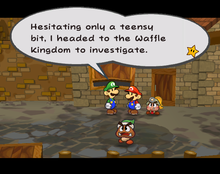
While Mario is on his mission to collect the Crystal Stars in Paper Mario: The Thousand-Year Door, Luigi is on a mission of his own. After every chapter in the game, Mario could find Luigi and listen to his story in Rogueport. When telling Mario the story, Luigi constantly exaggerated to make the story better and to make himself sound much more heroic; Luigi's partners (including Blooey, Hayzee, Jerry, Screamy and Torque), who generally hated him and only traveled with him because Luigi owed them a debt, almost always secretly told Mario what really happened. Later, Luigi got interviewed and five Super Luigi books were sold. Luigi's adventure involved rescuing Princess Eclair of the Waffle Kingdom from the Chestnut King. Luigi's story sounded extremely similar to Mario's in most aspects. He usually messed up during his adventure, such as accidentally knocking his partner Blooey the Blooper into lava.
Luigi also appears in the audience of Mario's battles, sometimes throwing helpful items to him. He also cheers Mario on during the final battle with the Shadow Queen, shouting "YOU GO, BRO!". His fan club, whose members include Toadia, a Toad from Poshley Heights, was also given two mentions in the game. The "L Emblem" Badge changes Mario's color scheme to Luigi's when equipped. The character Pennington constantly mistakes Mario for Luigi until almost the very end of the game. Lastly, Luigi's silhouette is the first of the many white character silhouettes that walk across the screen during the game's ending credits, continuing Luigi's past RPG roles as a parade leader.
- Tattle information
Who's this guy? ...Come on, you really need to ask me that? Gimme a break! That's your brother, Luigi! But...I wonder why he's here? I'm sure he'll tell you if you ask him.
Super Paper Mario
- See also: Mr. L
In the game Super Paper Mario, Luigi plays a very large role, much bigger than he did in the previous Paper Mario games; in fact, a considerable part of the entire story of the game depends on him (as the man in green of both prophecies, he must decide which one of them, the light or the dark, to trigger). He is noticeably as brave as Mario here, rushing in to save Princess Peach, jumping on Bowser, and calling Count Bleck a "goon". His special move is the super jump, which has him fold up then launch into the air. He is a playable character and the last character to join Mario's party.
At the beginning of the game, Mario and Luigi head to Bowser's Castle once they learn Peach has been kidnapped again. Luigi is then sucked into a vortex along with Bowser and his minions by Count Bleck. Luigi then wakes up during Peach and Bowser's forced marriage and attempts to stop the wedding, but fails. He is then rendered unconscious until the end of Chapter 2, where a pair of Goombas witness his awakening. Luigi wishes to try and save the Princess again, but the Goombas convince him to help them escape. They head off, but are stopped by a dead end. As they try to think of what to do next, Nastasia appears and hypnotizes one of the Goombas. Trapped by her and a group of Koopa Troop-turned-Bleck minions, the other Goomba simply surrenders to her and willingly joins Bleck's forces. Nastasia then orders the minions to hold Luigi in place as she brainwashes him. It is due to this that Luigi became Mr. L, also known as "The Green Thunder".
Before Mario could get his hands on the fifth Pure Heart, Mr. L makes appearance in the Whoa Zone, Mario and his team do not recognize that Mr. L is actually Luigi. Mr. L returns again as a boss during Chapter 6, after Sammer's Kingdom is destroyed. After being defeated, Dimentio betrays him and sends Mr. L to The Underwhere. He lost all memory of his having been Mr. L and returned to his normal state. Mario finds Luigi scared in The Underwhere (Chapter 7), and the two soon regrouped with the other playable characters (Bowser and Princess Peach) as well.
Eventually, Luigi faced Dimentio in Castle Bleck alone, without a single Pixl by his side. After defeating Dimentio, Luigi gets knocked out by Dimentio's fake suicidal attack. Peach later finds and awakens him, and they and Bowser later rejoined Mario, and their combined strength allowed them to defeat Count Bleck. However, Dimentio then snatched the Chaos Heart from him and activated a mind-controlling Floro Sprout he had planted on Luigi much earlier, turning his mind back into Mr. L. After explaining that the prophetic Dark Prognosticus stated that Luigi was the ideal host for the Chaos Heart, Dimentio merged himself and Luigi with the Chaos Heart, becoming Super Dimentio. After defeating Super Dimentio, Luigi returns to normal, and they all witness Count Bleck and Tippi using their love to stop The Void.
Paper Mario: Sticker Star

Luigi makes another appearance in Paper Mario: Sticker Star. Here, he can be seen in the backgrounds and scenery within five areas:
- W1-6: Goomba Fortress - While Mario crosses the bridge to the tower, Luigi is seen sitting on the wall in the background.
- W2-5: Drybake Stadium - When Mario reaches the fourth floor, if he takes the exit on the left, Luigi is sitting near a window on the right.
- W3-12: Whitecap Beach - As Mario walks along the pier, Luigi can be seen sitting on the rock on the right.
- W4-5: Whiteout Valley - Near the end of the ski ride, Luigi is seen sitting on one of the ski lifts going downhill.
- W5-5: Rugged Road - After the Save Block, Mario reaches an area with volcanic rocks falling from the sky, creating holes in the ground. Causing one rock to make a hole below an ledge lets Mario reach the underground. Heading north to a hot spring, Luigi is seen in another spring in the background.
The player can Paperize the environment to pull Luigi out, who appears in a small size. Luigi then jumps out of the scenery and leave. Upon finding Luigi in the five areas, he can be seen leading the parade at the credits (replacing the Green Toad), much like in Super Mario RPG, Paper Mario, and Paper Mario: The Thousand-Year Door. In Shy Guy Jungle, if the player keeps digging through the pile of paper, they may find a piece of paper that says a "mysterious green guy" was spotted at Goomba Fortress. The player can also read articles about Luigi's various appearances in the northernmost house in the east section of Decalburg. Sticker Star is notable for being the only game in the Paper Mario series where Luigi had no lines of dialogue.
Paper Mario: Color Splash
Luigi reappears in Paper Mario: Color Splash. Like in Paper Mario: Sticker Star, Luigi can be found in various places throughout Prism Island, which usually require Mario to use the Cutout ability to find him. He can be found in the following six areas:
- Bloo Bay Beach: Located in an outdoor shower room behind the juice bar.
- Marmalade Valley: Located near the Save Block found on the second level of the excavations area is an "L" carved into an inaccessible corner.
- The Golden Coliseum: Located on top of one of the spectator stands while Mario is in the arena.
- Plum Park: Located in the tree found in the area where Birdo is encountered.
- Redpepper Crater: Located in a waterfall within the hot springs area.
- Green Energy Plant: A sideways "L" can be found on a monitor outside on the far right near the Green Toad House.
Luigi plays a somewhat larger role compared to Paper Mario: Sticker Star where he helps Mario and Huey reach Black Bowser's Castle with his Standard Kart once all the Big Paint Stars have been found, as well as helping Mario and Peach escape said castle. Unlike Sticker Star, Luigi has dialogue this time around. If he is found in all of the six locations, he once again can be seen leading the ending parade while on his kart.
Paper Mario: The Origami King
This section is referring to a subject in an upcoming or recently released game. When the game is released, or more information about this subject is found, this section may need major rewriting.
This notice should be removed after a month has passed since the game was first released.
Luigi reappears in Paper Mario: The Origami King, where he can be seen driving a Standard Kart, similarly to his appearance in Paper Mario: Color Splash.[15] In the beginning, he and Mario are invited into Toad Town to celebrate the Origami Festival. Afterwards, while Mario and Olivia set out to cut the five streamers that are sealing Peach's Castle shut, Luigi busies himself hunting for the castle's keys.[16] After King Olly relocates Peach's Castle, Mario glimpses Luigi's hat left behind in the rubble. After traversing through the Whispering Woods and Graffiti Underground, Mario and Olivia locate Luigi in the castle ruins trapped in a wall. After being freed with the 1,000 Fold Arms, Luigi sets off to find the keys to Peach's castle. Throughout the rest of the game, Luigi can be found in many locations, often needing Mario's assistance, such as being trapped in the Ninja Attraction in Shogun Studios. When encountered, he will also give Mario what he thinks are the castle keys, but are always instead keys relevant to Mario's location.
Luigi's Mansion series
Luigi's Mansion
For the first time since Mario is Missing! and the Nelsonic Game Watch titled Luigi's Hammer Toss, Luigi gets his own solo adventure in Luigi's Mansion. Before the events of the game, Luigi wins a mansion in a contest he hadn't even entered. Overjoyed, Luigi tells Mario to go ahead and meet up with him there. Luigi walks through a gloomy, haunted forest that leads to a big haunted house. The mansion is actually the one Luigi is looking for and he gets nervous. Upon arriving, Mario is nowhere to be found. While searching for his brother, Luigi meets Professor Elvin Gadd who proceeds to tell him that the mansion is haunted and that Mario was taken captive. Handing Luigi his Poltergust 3000, a vacuum that can capture ghosts, Luigi sets out to find and rescue Mario. He captures all the portrait ghosts, the 50 Boos, and the game's main antagonist, King Boo, whom he has to fight with Bowser. Luigi defeats King Boo, gives the remaining portrait ghosts to E. Gadd, and rescues Mario and cries tears of joy.
Luigi's cowardice is more prominent in this game than most others; every time a ghost appears nearby or something makes a loud noise, Luigi gets startled, making him jump slightly into the air and prevents him from moving for a short time. Luigi also has a Health Meter that depletes whenever he takes damage, and if it reaches 0, Luigi dies. Unlike most other Mario games, Luigi cannot jump with a button command, which limits his movement. However, Luigi can use the Poltergust 3000 to suck in ghosts after stunning them with his Flashlight and shoot out fire, ice, and water blasts. Luigi reappears as the main protagonist in the Nintendo 3DS remake of Luigi's Mansion, though he now receives a slime-themed counterpart in Gooigi, who appears in the remake's co-op mode.
Luigi's Mansion: Dark Moon
In the sequel to Luigi's Mansion, Luigi's Mansion: Dark Moon, Professor E. Gadd calls for Luigi's help from Evershade Valley and transports him over there with E Gadd's Pixelator. Once there, Luigi is told the Dark Moon has shattered and that the valley's normally friendly ghosts have become mischievous and hostile. E. Gadd then sends Luigi to the first mansion, Gloomy Manor, to retrieve the improved version of the Poltergust 3000, called the Poltergust 5000, and to see what he can find out. In the process, Luigi catches ghosts, including the powerful Poltergeist, with the Poltergust 5000. He later enters the manor's cellar, where the Grouchy Possessor takes control of a massive spider and attacks Luigi. Luigi manages to catch this ghost, return the spider to normal, and recover the first Dark Moon piece. He is subsequently transported back to E. Gadd's lab.
Luigi's next destination is the Haunted Towers, which were revealed due to the collection of the Dark Moon piece. Here, Luigi catches more ghosts (such as The Three Sisters) and rescues one of E. Gadd's Toad assistants. In addition, he encounters Polterpup for the first time, but when Luigi captures this ghost, he escapes. Luigi eventually encounters a staircase being controlled by the Harsh Possessor. He catches this ghost, returns the staircase to normal, and recovers the second Dark Moon piece. He is then returned to E. Gadd's lab.
Next, Luigi goes to the Old Clockworks. Here, he catches more ghosts (including the Ancient Poltergeist) and rescues another Toad assistant. He also finds Polterpup and catches the ghost again, but he again escapes. After recovering the clock hands (that were stolen by a group of Greenies), Luigi goes to the top of the tower and locates the Overset Possessor. The possessor controls the clock on the tower to attack Luigi, but is caught. Luigi then recovers the third Dark Moon piece and returns to the lab again.
Luigi then goes to Secret Mine. Here, it is discovered that certain ghosts are being powered up in the mine. Regardless, Luigi catches them and finds the Shrewd Possessor, who controls a pool of ice. This ghost is also caught, and Luigi recovers the fourth Dark Moon piece.
E. Gadd then tells Luigi that the final Dark Moon piece is in the Treacherous Mansion, although he warns that his Parascope is picking up extremely high paranormal signals from the area (which frightens Luigi) before sending Luigi there through the Pixelator with the mansion key. Just as Luigi goes to unlock the mansion's front door, the key is stolen by Polterpup. Luigi chases the ghostly dog and retrieves the key, finally catching Polterpup in the process. After entering the mansion, Luigi catches more ghosts (including the Strong Poltergeist) and rescues more Toad assistants. A photo received from one of the assistants reveals that King Boo and his Boo minions have trapped Mario in a painting (much like in the first Luigi's Mansion). Recognizing the location in the picture as the Train Exhibit in the Treacherous Mansion, E. Gadd sends Luigi there to rescue Mario. However, Luigi and E. Gadd soon discover that it was a trap, and Luigi is ambushed by Big Boo; a large Boo made up of many smaller Boos (who Luigi subsequently captures). Back at the lab, Luigi and E. Gadd ponder where King Boo and the painting are. Soon after, the Parascope picks up strong readings from the Treacherous Mansion's terrace. Luigi is sent there, where King Boo appears and opens the paranormal portal, which releases a large number of ghosts into the mansion, then escapes with the Mario painting inside. E. Gadd tells Luigi to capture the ghosts in the mansion, as the paranormal activity is so strong that their dimension could collapse upon itself. Luigi does this then enters the Paranormal Portal, arriving in King Boo's Illusion.
In the portal, Luigi finds the final Possessor ghost, the Tough Possessor, who clones himself and controls multiple suits of armor. The final Possessor is caught, and Luigi finds the final Dark Moon piece. E. Gadd attempts to transport Luigi back to the lab. However, King Boo interrupts and sends Luigi into an illusion. Here, Luigi and King Boo fight. Before the fight, King Boo reveals that he was the one who shattered the Dark Moon and captured Mario. Luigi is ultimately victorious, catching King Boo, taking his crown, and rescuing Mario with the Dark-Light Device. Luigi, Mario, and E. Gadd rejoice, and a Greenie takes a photo with them and the now once again friendly ghosts (due to the restored Dark Moon). Luigi then takes in Polterpup as his pet, and Polterpup is later seen sleeping on Luigi, with Luigi seemingly overcoming his fear of ghosts.
Luigi's controls and personality are mostly retained from the previous game. Luigi still can't jump, but he isn't as easily frightened from ghosts, being able to still move around while being startled. Luigi's Health Meter also returns, functioning the same way as it did in the original game, though players can recover from a Game Over if they have found a Gold Bone. While the Poltergust 5000 can't shoot out elemental blasts, Luigi can still use it to suck up ghosts and objects, cause a wider and stronger beam of light, and reveal hidden objects.
Luigi's Mansion 3
Luigi appears as the main protagonist in Luigi's Mansion 3. He has a new Poltergust that can fire plungers and lift him off the ground, along with using the Strobulb and Dark-Light attachments, as well as storing Gooigi.
In this game, Luigi was invited to stay at The Last Resort hotel, and brings Mario, Princess Peach, three Toads and Polterpup. However, that night the hotel turns haunted and it is revealed that the invitation was set up by Hellen Gravely so that King Boo could trap Luigi and his friends in paintings. Just as King Boo was about to trap Luigi, he manages to escape through a laundry chute.
Luigi ends up in the basement where he finds the Poltergust G-00 in a car. He later finds Professor E. Gadd trapped in a painting on the second floor, and after releasing him with the Dark-Light Device, E. Gadd aids Luigi once more by providing him with the Virtual Boo for communication, and Gooigi.
To advance through the hotel, Luigi must retrieve the missing elevator buttons from the ghostly hotel staff, freeing the three Toads along the way. Once Luigi reaches the top and defeats Hellen Gravely, he rescues Mario, who leads him to the rooftop where Peach is. After releasing Peach, however, King Boo traps everyone besides Luigi, who was saved by Polterpup, in a single painting. King Boo, enraged that he missed Luigi, engages him in battle.
After Luigi defeats King Boo, the entire hotel collapses from taking the bulk of the battle. Polterpup saves Luigi once again, and frees everyone from the painting. During the credits, Luigi helps rebuild the hotel with the newly-turned friendly ghosts, and after construction was complete, departs with Mario, Peach, Polterpup and the Toads.
Mario & Luigi series
Luigi appears as one of the titular characters in the Mario & Luigi series, alongside his brother, Mario. Luigi is often forced into adventures alongside Mario though comical means (Bowser mistaking him as a new recruit in Mario & Luigi: Superstar Saga, being pushed into a time hole in Mario & Luigi: Partners in Time) and is shown to be reluctant in various activities within the adventures, but still follows Mario's lead regardless. In some scenarios, he has even been forced to venture off on his own in order to save Mario (in Mario & Luigi: Superstar Saga he must go to Guffawha Ruins to retrieve Crabbie Grass to cure Mario of his bean fever and in Mario & Luigi: Bowser's Inside Story where he must rescue Mario from a Sockop). In battle, Luigi usually boasts a high HP stat along with a decently high defense stat, making him a decent supporting character. Compared to Mario, Luigi has a lower speed stat and slightly lower power stat.
Mario & Luigi: Superstar Saga / Mario & Luigi: Superstar Saga + Bowser's Minions
In Mario & Luigi: Superstar Saga and its remake, Luigi joins Mario on his adventure. Though he originally didn't intend to go, Bowser scooped him up and brought him along in the Koopa Cruiser and they headed off to the Beanbean Kingdom. Luigi's personality shines through during this adventure, as he is often reluctant to do anything dangerous. One such time is when Mario comes down with the Bean Fever and Luigi must go to Guffawha Ruins to find the cure, though hearing of the dangers, he becomes too scared to move properly, disabling his Jump command for the time being. He also briefly poses as Princess Peach via Peach's Extra Dress in an attempt to rescue her, successfully tricking Fawful and Bowletta into releasing Peach and abducting him. However, he is ultimately forced to reveal his true identity when Bowletta, suspicious about "Peach" covering "her" mouth, tricks "her" into turning around by claiming a giant cockroach was behind "her", although he does ultimately retrieve the actual Beanstar from Bowletta.
Luigi's actions and attributes differ from Mario's as well. For example, Luigi has higher HP, but lower attack power than Mario. While both he and Mario can both Jump and use Hammers, the actions they perform depend on their positioning. Luigi can learn the High Jump, which has him jump on to Mario to jump higher, and he can also turn Mario into Mini-Mario by hitting him with his hammer, both are performed if Luigi is in the back. Additionally, Luigi can burrow into the ground if he is hit with Mario's hammer if Mario is in the back. Later in the game, the bros. learn special hand techniques; in Luigi's case, the Thunderhand, which has him create a ball of electric energy in front of him that can power Conductors. If used on Mario while Luigi is in the back, he stuns him, allowing them to move in sync while facing in one direction.
While Luigi can use his standard techniques in battle, Luigi has different Bros. Attacks than Mario as well. Bounce Bros., Knockback Bros., and Thunder Bros. are taught to Luigi at the same time as when Mario learns his variants, with Cyclone Bros. being a hidden skill obtained when winning the Secret Scroll 2 in a minigame located the Hammerhead Bros.' cave after gaining the Ultra Hammer.
Mario & Luigi: Partners in Time
- See also: Baby Luigi
In Mario & Luigi: Partners in Time, Mario and Luigi travel through time between the past and the present. While in the present, Luigi meets his infant self, Baby Luigi. The two team up with Mario and his baby self in order to find Princess Peach, who has been kidnapped by the Shroobs. Luigi's cowardly personality is still apparent, with his younger self seemingly having more courage than him. When talking to the Star Gate and completing the quest given, it is shown that Luigi has a very large heart and cares deeply for his brother and friends.
While Luigi retains his Jump ability, the Hammer commands are given the younger versions of the bros. Luigi also does not have his High Jump, instead gaining Mario's move from the last game, the Spin Jump, which allows him and Mario to float across large gaps. Later, he and Mario learn the Bros. Ball technique, which has him and Mario curl into a ball and allows them to move faster.
Mario & Luigi: Bowser's Inside Story / Mario & Luigi: Bowser's Inside Story + Bowser Jr.'s Journey
At the start of Mario & Luigi: Bowser's Inside Story, the Bros. go to an emergency meeting in Peach's Castle, warning about the dangerous disease plaguing the Mushroom Kingdom, called the blorbs. Mario and Luigi arrived in the castle so hastily that Luigi was first shown hopping on one foot while trying to put on his overalls, causing him to trip and fall face-first on the floor. During the meeting, Luigi ends up falling asleep, causing him to miss the fight between Mario and Bowser. Once Luigi is inhaled into Bowser's body due to the Vacuum Mushroom, he lands in the Trash Pit and has to be rescued by Mario. Afterward, he joins his brother on the adventure. At one point during the adventure, however, Mario is separated from Luigi by a gang of Sockops, forcing Luigi to rescue him alone.
While Mario and Luigi's controls are relatively the same, Luigi has additional commands. On the field, Luigi can once again turn Mario into Mini-Mario by hitting Mario with Luigi's hammer. Luigi joins in on Mario's Spin Jump, though Luigi can activate Drill Bros., which burrows the brothers into the ground, allowing them to dig under gates or uproot items such as Beans.
Luigi also has his own set of Badges, which boosts the effect of Mario's corresponding badge.
In the 3DS remake, Luigi makes a brief appearance in the new Bowser Jr.'s Journey mode, where he and Mario pass by Bowser Jr. who picks a fight with them. Starlow stops them from fighting however, reminding them that there is no time for this, even for Bowser Jr. In the story timeline, this event happens while searching for the Star Cures.
Mario & Luigi: Dream Team
- See also: Dreamy Luigi
Luigi makes an appearance in Mario & Luigi: Dream Team, the fourth installment of the Mario & Luigi series. Due to the game being released during the Year of Luigi, Luigi's role is far greater than the previous entries in the series. Luigi's appearance has also been updated from the previous three games, as his overalls hide his socks and the L on his cap is green, to match his appearance from the main games.
When in the Real World, Luigi can use his hammer to turn Mario into Mini-Mario once again, though only on hard surfaces like rock or metal. If on soft surfaces, such as dirt or sand, the move becomes Mole Mario instead, which pounds Mario into the ground. He also learns the Side Drill, which sends Mario and Luigi spinning in the direction they are facing like a drill, breaking certain blocks and obstacles. Finally, he and Mario can use Ball Hop, which allows them to jump higher and reach previously inaccessible areas, which is an apparent combination of the High Jump and Bros. Ball from the first two Mario & Luigi games.
Luigi's biggest role in this game is opening portals to the Dream World whenever he sleeps on a Pi'illo, which Mario jumps into and Dreamy Luigi, a dream varient of Luigi, assists him while in the Dream World. Mario is unable to open Dream World portals however, as shown early in the game. According to Prince Dreambert, this is because Luigi's REM wavelength is in the same range as that of a typical Pi'illo.
One of the main elements in the Dream World are the Luiginary Works, which has Dreamy Luigi transform into various different things by interacting with the objects around him, and are activated by Starlow doing certain things to the sleeping Luigi's face. However, certain transformations are limited to specific areas. A type of Luiginary Work, called the Luiginoid Formation, involves Luiginoids created from the stars of a constellation that can be stacked, and will instantly defeat enemies that come into contact without battling them, and will even permenantly remove them from the overworld. One such transformation has the Luiginoids turn into a giant, much like how Bowser turned into a giant in the previous game. During battles, Dreamy Luigi will merge with Mario, raising his stats, and assists him with basic attacks along with allowing him to use Luiginary Attacks; the Dream World's variant of Special Attacks.
Both versions of Luigi also have their own special attacks, with the "real" Luigi having different Bros. Attacks than Mario, and Dreamy Luigi having Luiginary Attacks that involve the Luiginoids.
Mario & Luigi: Paper Jam
For the first time in the series, Luigi starts off the adventure in Mario & Luigi: Paper Jam. He and a Toad enter the attic of Peach's Castle. Through a series of events involving a Scaredy Rat, Luigi knocks over a book that contains the characters from the Paper Mario series. Upon landing, the book opens, releasing the characters from that world into the world of the Mario & Luigi series. Luigi soon meets up with Mario and the paper version of Mario to help put things back together.
Luigi controls much like how he does in the previous Mario & Luigi games. He gains additional Bros. Attacks and assists in the Trio Attacks, but overall Luigi is not much different from the other games. He does, however, have a Papercraft based on him called Papercraft Luigi, which allows the player to use the Flying Hammer Attack that can damage spiked enemies. Additionally, several Battle Cards have artworks of Luigi from previous games.
During the second visit to Gloomy Woods, Mario and Paper Mario are both captured by King Boo, and Luigi must rescue them alone, similar to the Luigi's Mansion series.
A paper variant of Luigi is seen sleeping next to a gramophone when the player is viewing the Music Player.
WarioWare series
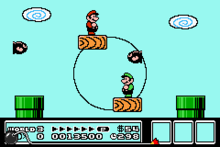
Luigi rarely appears in the WarioWare series. In WarioWare: Twisted!, Luigi appears alongside his brother in Super Mario Bros. 3-Lift, where he appears on the Level 3 variant of the minigame and he (along with Mario) must dodge incoming enemies. He also appears in Mario Brothers, again during the Level 3 variant, where he and Mario try to kick the enemy before the player can flip it back up-right.
In WarioWare: Touched!, Luigi appears alone in the third level of the microgame Spin a Yarn. On the 3rd level difficulty, the player can unravel a Luigi making an "L" formation.
In WarioWare: Smooth Moves, Luigi is one of the main instrumentalists who plays the violin in 9-Volt's microgame, Opening Night.
In WarioWare Gold Luigi appears in the Mario Bros. microgame, and also reprises his role in Super Mario Bros. 3-Lift, now known simply as "Super Mario Bros. 3."
NBA Street V3
Luigi, along with Mario and Princess Peach, as a result of the Nintendo and EA partnership, makes a fully playable guest appearance exclusive to the Nintendo Gamecube version of NBA Street V3. The three are part of a team entitled "Nintendo All-Stars", alongside other all-star basketball teams. Luigi's team additionally has a special basketball court.
SSX on Tour
Luigi, Mario, and Peach, as with NBA Street V3, make another playable guest appearance in the Nintendo GameCube version of SSX on Tour, stemming from the same partnership with Nintendo and EA. In SSX on Tour, Luigi snowboards in a mountain and performs various stunts to earn points.
Dance Dance Revolution: Mario Mix
In Dance Dance Revolution: Mario Mix, Luigi is one of the characters (with the other being Mario) that can be chosen at the start of the single-player adventure. Aside from the cap at the starting house changing from Mario's to Luigi's, nothing in the adventure is changed. Luigi travels with Toad to recover the stolen Music Keys in Mario's place.
Luigi also appears as the second player during the two-player Dance-Off mode.
Mario Baseball series
Mario Superstar Baseball
In Mario Superstar Baseball, Luigi is an alternative captain to Mario. His team names are the Luigi Gentlemen, Luigi Vacuums, Luigi Mansioneers, and Luigi Leapers. Luigi has similar stats and abilities to Mario, but Luigi can perform a Super Jump on the field while Mario cannot, and his Star Pitch is the Green Fireball. Luigi's stats are well balanced, although his batting skills are slightly weaker than his other skills.
Mario Super Sluggers
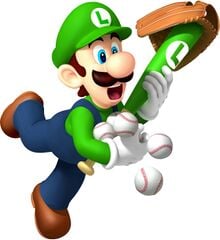
In Mario Super Sluggers, Luigi is a team captain, leading his team called the Luigi Knights. Luigi, along with Bowser Jr. and Daisy, are the only secondary team captains to have a home stadium, with Luigi's being Luigi's Mansion. Compared to the predecessor, Luigi's batting, fielding, and running have been improved slightly, while his pitching skills remained the same. He gained the Star Swing Tornado Swing along with a new Star Pitch called the Tornado Ball to differentiate him from his brother. In challenge mode, Luigi is the first player that joined the team. Luigi's Mario Super Sluggers baseball card listed his Rookie Year as 1982, although Mario Bros., the game that he first appeared in, was released in 1983.
Super Princess Peach
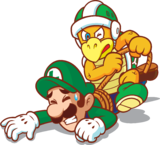
During the opening story of Super Princess Peach, Mario, Luigi, and several Toads were taken captive by Bowser and his minions, using the power of the Vibe Scepter. While Mario was guarded by Bowser himself, Luigi was given to a Giant Kamek to be guarded. Once Princess Peach defeats the Giant Kamek, Luigi (called "the green man") is rescued. Luigi does not appear again until Mario is rescued at the end of the game, where he is shoved to the side by Peach as she runs to Mario.
Mario Strikers series
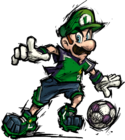
Luigi is a team captain in Super Mario Strikers (also known as Mario Smash Football in the PAL regions). Luigi's number in Super Mario Strikers is 2, probably referring to him being Mario's "younger brother" and him usually filling the "Player 2" role in earlier titles. His emblem is a lightning bolt, an element he has been associated with since Mario & Luigi: Superstar Saga. In the game, his Super Strike is the Vicious Vortex.
Luigi returns as a team captain in the sequel to Super Mario Strikers, Mario Strikers Charged (also known as Mario Strikers Charged Football in the PAL regions). He is now classified as a Balanced player alongside Mario, meaning his stats are well-rounded and he does not have any glaring strengths or weaknesses. Luigi's Super Ability is Super Luigi!, which allows him to become giant and crush his opponents, opening scoring opportunities, and his Mega Strike is called Thunder Luigi, which completely electrifies Luigi and the soccer ball.
Mario Hoops 3-on-3
Luigi appears in the game Mario Hoops 3-on-3 as one of the starting playable characters and is an All-Around character. To use his Special Shot, the Green Fire Shot, the player has to tap out the letter "L" twice on the touch screen. Luigi's Baller name is the Mushroom Dynamite.
Fortune Street series
Luigi appears as an unlockable character in Itadaki Street DS, unlocked by playing through the Tour Mode of the game. He is a Rank C character when controlled by the computer. Several pieces of Luigi's clothing and gear also appear as unlockable customizations for the player's avatar character.
Luigi returns in the Wii follow-up to Itadaki Street DS, Fortune Street, this time as an initially playable character. Like in the last game, Luigi is a Rank C character when he's a computer controlled character.
Mario & Sonic series
Luigi is a playable character in every one of the Mario & Sonic series as an All-Around character. His emblem in the series is his trademark green "L".
In the story mode of DS version of Mario & Sonic at the Olympic Winter Games, Luigi is found in Frostown. He asks Mario and Sonic to challenge him at Cross Country. Upon being defeated, he joins their party. Once at Sparkleton, Luigi helps Mario and Sonic look for a key. A Boo scares Luigi away, which makes Luigi run into a tree, causing the key to fall from it and Boo steals it. Luigi gives chase to the Boo and, if gets the key in less than forty seconds, the Boo runs away and reports to King Boo. After the players clear the ice walls at Polastraits, King Boo is angry when the Boos tell him that Luigi upset them in Sparkleton. Luigi challenges him on Alpine Skiing GS. After Luigi beats King Boo, King Boo flees.
In the 3DS version of Mario & Sonic at the London 2012 Olympic Games, Luigi takes part in the Heroes Story portions of the story mode. Here, he journeys with Mario, Sonic, and Tails to find the source of the strange fog covering London. There is also a Mii costume based on Luigi, which is carried over into later games in the series.
While Luigi is playable for all events in the Wii U version of Mario & Sonic at the Rio 2016 Olympic Games, he is only playable in the Table Tennis and 110m Hurdles events in the 3DS version.
Luigi reappears in Mario & Sonic at the Olympic Games Tokyo 2020 as an All-Around-type playable character. He is one of the eight characters that are playable in 2D Events.
Mario Sports Mix
Luigi appears in Mario Sports Mix, where he is classified as an all-rounder (all-around in North America) type character. His speed is average, while he has an above average technique, though his power is below average. His special move involves Luigi pulling out his Poltergust 3000 from Luigi's Mansion to suck his opponents toward him, followed by firing the ball at the intended target. Luigi also has a court based on his mansion that can be played on during the Vollyball and Basketball modes.
Dr. Mario series
In Dr. Luigi, Luigi gains the role of a doctor, much like his brother's persona. In Dr. Luigi, his appearance is similar to Dr. Mario's, but Luigi wears his cap instead of a doctor's head mirror. In Dr. Mario: Miracle Cure, Luigi gains a head mirror to wear. Like Dr. Mario, Luigi in his doctor persona makes use of Megavitamins to defeat Viruses. In a similar fashion to Dr. Mario, Dr. Luigi will toss Megavitamins that the player has to control in order to eliminate the Viruses.
It has been suggested that Dr. Luigi has a more laid-back personality than his brother, as in the introduction cutscene to Dr. Luigi, he is seen walking slowly with a tired look on his face. After he sees the Viruses, however, he becomes shocked and prepares Megavitamins for use, now looking worried.[17]
Dr. Luigi returns as an unlockable playable character in Dr. Mario World. His special ability is eliminating random viruses in an L shape.
Puzzle & Dragons: Super Mario Bros. Edition
In Puzzle & Dragons: Super Mario Bros. Edition, Luigi is one of the main characters. If Luigi is selected as the leader, he can call on others as a helper. If anyone else is the leader, Luigi can be called as a helper. Luigi shares the same number of forms as Mario, having eighteen forms, all of which are based on power-ups from other games and can be seen here.
Minecraft
In the Super Mario Mash-Up Pack in Minecraft, Luigi appears as a playable skin. Luigi wearing the Poltergust 5000 and Kitsune Luigi also appear as skins.
Mario Sports Superstars
Luigi appears in Mario Sports Superstars as a Balance type character in most sports; in tennis, he is the similar All-Around type instead. Due to this, Luigi has no glaring weaknesses in his stats, but does not excel in any one stat in particular. In golf, Luigi's default drive is 209 yards, and his shots travel low in a fade trajectory.
Mario + Rabbids Kingdom Battle
Luigi appears as a playable character in Mario + Rabbids Kingdom Battle as one of the playable characters. Like with the others present at the statue inauguration at the beginning of the game, Luigi was sucked into the vortex linking the Rabbids to the Mushroom Kingdom. He was later seen being terrorized by Pirabbid Plant in the level Brother, Where Art Thou?, forcing Mario, Rabbid Luigi, and Rabbid Peach to rescue him. Luigi promptly joins the group once the level is completed.
Luigi is a character with high offense and maximum mobility, though his defense is very low. He is the only character with access to Precision weapons as his main set of weapons and he uses Sentry weapons as his secondary set.
Luigi alongside Mario and Rabbid Luigi are briefly present in the opening cinematic for Mario + Rabbids Kingdom Battle's Donkey Kong Adventure DLC, where they try to stop Rabbid Peach from disappearing with Beep-0, the Time Washing Machine, Rabbid Kong, and a few Rabbids, but fail to do so.
Other portrayals
The first live-action portrayal of Luigi was in a commercial for Mario Bros. from 1983[6].
General information
Concept and creation
The arcade game Mario Bros. incorporated a multiplayer mode, but due to memory restrictions, the second player character needed to have a sprite identical to the first. The development team thought of differentiating the second character by giving him different colors, but the color palette budget was similarly limited.[18] As a result, Luigi was conceived as a twin of Mario to explain his resemblance and he was made green to recycle the color palette of the Shellcreeper enemy.[18]
Physical description
Compared to Mario, Luigi is slimmer and taller. His face is noticeably thinner, his eyes are slightly more bluish, and his hair is the same style as Mario's, but more of an auburn or dark maroon. Luigi's mustache is dark brown, sometimes black, and smooth, unlike Mario's ragged mustache. In Mario & Luigi: Paper Jam, during a cutscene in Twisty Tropics dungeon, Luigi's mustache fell off, implying that it may be fake.
Luigi also wears clothes similar to Mario, but his shirt and cap are green instead of red. Layered over the shirt is blue overalls, which are a darker blue than Mario's. He also has brown work shoes, again darker than Mario's, with tan bottoms that reach above his ankles. Artwork however sometimes shows Luigi with the same color of blue overalls and brown shoes as Mario. In Luigi's Mansion, Luigi's shoes have Velcro on them, which is not present in any other game. The Luigi Cap is similar to the Mario Cap, being green instead of red and having an "L" replace Mario's signature "M"; the "L" was in italic from Mario Kart 64 to Luigi's Mansion for a few years. Artwork for the Mario & Luigi series has consistently depicted Luigi as wearing red-and-white striped socks; this trait is not present in any other games.
Mario and Luigi's color preferences are reflected throughout the land in the form of various enemies, such as Koopa Troopas and Cheep-Cheeps, who also come in red and green varieties. These foes even reflect the brothers' personalities, with red ones being more aggressive and green ones acting cautious. In fact, Mario and Luigi are not the only known red and green brothers, with similarly color-coded siblings including Cork and Cask, the Red and Green bridge guards, the Armored Harriers, Massif Bros., Elder & Junior Shrooboid and Gigi and Merri. When tattling the younger of the Armored Harriers, Goombella theorizes that it may be some sort of rule that younger brothers must wear green, offering a possible explanation for Luigi's trademark green shirt and cap.
However, Luigi has not always chosen to wear his usual green and blue clothes. Mario Bros. originally dressed Luigi in a black shirt and green overalls, although artwork showed his shirt to be red. Shigeru Miyamoto stated that the green color of clothing for Luigi was inspired by the enemy Shellcreeper.[19] Wrecking Crew gave him a magenta pair of overalls and helmet, seemingly leaving him shirtless. Even Super Mario Bros. gave its Luigi a green shirt and white overalls (although Super Mario Bros. Deluxe replaced this with a less aberrant brown shirt and green overalls, leaving his original colors to Fire Luigi, who usually has an inverse scheme), even though his usual palette and appearance had emerged in artwork. Fire Luigi's palette in Super Mario Bros. uses the color scheme used by Fire Mario.
Luigi originated as being a palette swap of Mario in his earlier adventures. This applies to Mario Bros., Wrecking Crew, Super Mario Bros., Super Mario Bros. 3, Super Mario World, Super Mario World 2: Yoshi's Island, and in a few versions of Mario is Missing!. Luigi's first depiction as taller and thinner is in Famicom Grand Prix II: 3D Hot Rally, although Luigi's first unique sprites came in Super Mario Bros. 2, in which his artwork appearance conveniently coincided with the tall Mama's sprite.[2] Nintendo of Japan would not adapt Luigi's artwork differences to his in-game sprite until Super Mario Kart, although Luigi's various models have been unique almost ever since, even in remakes of games where he was originally a palette swap (such as Super Mario All-Stars, Super Mario All-Stars + Super Mario World, Super Mario Advance 2, and Super Mario Advance 4). However, Luigi's appearance in Super Mario Maker 2's Super Mario Bros. and Super Mario Bros. 3 styles revert to depicting him as a palette swap of Mario - most likely in order to be faithful to his original designs - though in the Super Mario Bros. 3 style, his color scheme is a darker shade of green; on an interesting note, his fire form's colors in both styles are reimagined. In the game's Super Mario World style, Luigi's unique head shape from Super Mario All-Stars + Super Mario World is retained, though his body shape and his animations revert to those in Super Mario World.
Both Mario and Luigi have been described as "cutesy," to the extent that Shigeru Miyamoto considered redesigning them to "become a bit more grown-up" in the GameCube era—for instance, by removing their trademark V sign.[20] However, aside from growing more realistic as graphics have advanced, Luigi and his brother have changed little over the years, and continue to flash the V sign regularly.
Luigi's appearance does, however, tend to lend itself to heavy stylization. The Luigi's Mansion graphical team took it upon themselves to animate every part of Luigi to convey emotion,[21] resulting in such exaggerations to his body as head-expanding screams during boss cutscenes and complete flattenings by fake doors. The Super Smash Bros. series applies Luigi's cowardice to his actions, making most of his attacks look reckless and unwilling and giving him awkward movements, securing his official title as the series' "dreamy, comical poster boy."[22]
Luigi's appearance has changed quite a bit throughout the Super Smash Bros. series. In the original Super Smash Bros., Luigi's overalls are indigo, with his entire appearance being original. In Super Smash Bros. Melee, Luigi borrows his appearance from Mario Kart 64, right down to having a tan complexion; Luigi's overalls are now their standard navy blue color, though they receive denim textures and back pockets. In Super Smash Bros. Brawl, Luigi uses his contemporary look, though his overalls have further pronounced textures, while his hair and other clothing receive simple detailing. In Super Smash Bros. for Nintendo 3DS / Wii U, Luigi's model is sleeker and more vibrant, while his hair and clothing lose most of their detailing. In Super Smash Bros. Ultimate, Luigi receives simple detailing in his hair and clothing once again, albeit not to the same extent as in Super Smash Bros. Brawl.
Luigi has a total of eight selectable costumes to date in the Super Smash Bros. series, with 4 in Super Smash Bros. and Super Smash Bros. Melee, 6 in Super Smash Bros. Brawl, and 8 in Super Smash Bros. for 3DS / Wii U and Super Smash Bros. Ultimate. In Smash 64 and Melee, Luigi had his first three costumes introduced; the first costume consists of green overalls and a white undershirt and cap, which are derived from Fire Luigi's colors; the second costume consists of blue overalls and a cyan undershirt and cap, resembling Mario's appearance on the American boxart for Mario Bros.; lastly, Luigi's third alternate costume consists of red overalls and a pink undershirt and cap, resembling his appearance in Wrecking Crew. In Brawl, Luigi's fourth and fifth alternate costumes were introduced: the former consists of blue overalls and an orange undershirt and cap, resembling Mario's appearance on the boxart for Pinball; the latter consists of dark indigo overalls and a purple undershirt and cap, based off of Waluigi's colors. In 3DS / Wii U, Luigi's sixth and seventh alternate costumes are intorduced: the former consists of blue overalls, a dark blue cap, and a garbage green undershirt; the latter consists of teal overalls, and a dull yellow undershirt and cap; neither of these costumes has inspirations.
Personality
Luigi is portrayed as timid and a bit of a coward. He is also extremely worrisome and is considerably self-conscious. However, he overcomes his fears and acts like a hero when necessary, such as when someone he knows is in danger or needs help. On the New Super Mario Bros. Wii website, it describes Luigi as "Mario's fearless brother". In keeping with his personality-based Power Flower, a sign in Big Boo's Haunt in Super Mario 64 DS describes Luigi as "wispy."
Arguably, Luigi's most apparent trait is his seeming cowardice. Though he showed several instances of cowardice in early non-game media such as The Super Mario Bros. Super Show!, his cowardly nature was not actually shown in-game until Luigi's Mansion (aside from a few hints in Paper Mario), and has carried over to almost all of Luigi's subsequent appearances. Although Luigi's phasmophobia is his most overbearing fear, he usually reconsiders at the mere thought of any monsters or trials, especially in the Mario & Luigi series. However, Luigi can be quite brave, and has saved the Mushroom Kingdom alongside his brother multiple times. Super Paper Mario especially glimpses into Luigi's more courageous side, showing him boldly rushing into dangerous situations and rarely even implicating his infamous cowardice. In addition, the endings for Luigi's Mansion: Dark Moon and Luigi's Mansion 3 also hinted that he overcame his phasmophobia, or at the very least takes exception to Polterpups and makes friends with the friendly ghosts of Evershade Valley and the Last Resort hotel. In Simon Belmont's reveal trailer for Super Smash Bros. Ultimate, Luigi is clearly scared of all the creatures in Dracula's Castle, though he attempts to ward them off with the Poltergust's flashlight, as well as a toilet plunger.
Another strong element of Luigi's personality is his apparent complex of being overlooked. Although his Superstar status has earned him many fans, including an entire fan club led by Toadia and multiple supporting Toads (one of which claims to be his biggest fan in Super Mario 64 DS), even Bowser and the Koopa Troop have occasional trouble with remembering his name (as seen in Mario & Luigi: Superstar Saga), and he appears to be almost unknown in the Beanbean Kingdom. Although Luigi's biggest reactions to his frequent overlookings in the Mario & Luigi series are a few "…"s and face-faults, his inattention was played up for comic relief in Paper Mario, with the snarky man in green complaining about being left behind and perpetually training for that elusive next adventure. Luigi's bio in Mario Party 5 states that he has been gaining popularity in recent years.
Luigi's state of being in the shadow of his brother shows strongly in Super Smash Bros. Brawl. An example would be the way Luigi is almost never happy, how his commentary is very monotoned, and how one of his taunts is a bashful kick of the ground. Also, his Final Smash, Negative Zone, seemed to have developed because of living in his brother's shadow forever. Additionally, whenever the crowd cheers for Luigi, not too many people are heard cheering for him and when the announcer says Luigi's name, he sounds a little surprised. Snake's codec conversation even has the Colonel refer to Luigi as the "kid brother" and "king of second bananas", despite Snake's protests. Despite this, however, Masahiro Sakurai did not intend to play up Luigi's overshadowed status, instead aiming to make him "everyone's favorite man in green."[22] Luigi's state in the shadow of Mario is present in other Super Smash Bros. games, since the original Super Smash Bros. addresses him as the "eternal understudy" when he's unlocked; Super Smash Bros. Melee also refers to him in a similar manner, and his cinematic in the game's Adventure Mode shows him Footstool Jumping Mario, signifying his tiredness of being number two. In Super Smash Bros. for Wii U, whenever a Palutena's Guidance conversation is activated when fighting against Luigi, Viridi and Palutena are quick to point out Luigi's status as "number two" in relativity to Mario, even though Pit held him in a higher regard.

The Super Smash Bros. games make Luigi a comical, yet depressive figure, which is evident by his aforementioned unhappiness, his violent taunt, quiet commentary, and origin of Negative Zone, yet, several other actions show Luigi behaving childishly. These include: his dash attack, where he swings his arms aimlessly while keeping a humorous panicking expression; his neutral attack, where he hits opponents with his butt for the third hit; his up tilt, where he "paw swipes" the opponent with his fists while closing his eyes; the aftermath of his Super Jump Punch, where he falls upside-down; his idle poses, where he scratches the back of his head sheepishly or humorously pulls his nose before wincing in pain; and his victory poses, which have him do the following: breathing heavily with his eyes half-closed, falling stiff and planking on the ground (also one of his taunts), or childishly making finger pistols and pretending to shoot his opponents (which is supported by him saying "Bang, bang!").
When Luigi finally went on a quest of his own in Paper Mario: The Thousand-Year Door, he's presented as more arrogant and somewhat of a liar, as he changes the stories of his adventure to make himself look better; his partners claim his stories are false. The novelizations of his escapades describe them with even more flowery exaggerations, stating for instance that he played an earth spirit in the Jazzafrazz Town Drama Slam (whereas he actually played grass on the side of the road, according to Hayzee) and that he awoke Cranberry with "a soft call" (rather than a sneeze).
In Mario & Luigi: Partners in Time, the Star Gate (which supposedly knows all) passes Luigi as "unworthy" to enter. This most likely has something to do with Luigi's "dark secret from his past," which it also mentions; Luigi did something either embarrassing or foolish which he has kept a secret ever since. However, in an interview with a member of staff, he stated that Luigi had no dark secret, and it was actually a reference to Luigi's constantly living in the shadow of his brother.[citation needed] Even the game itself makes a straightforward point that Luigi has a large heart, as proven when he hits the Aurora Block and it grows to a gigantic size, flattening him.
In Mario Strikers Charged and Mario Kart Wii, Luigi is shown to cry when he is frustrated and losing a game.
Luigi is also portrayed as somewhat refined, leading the "Luigi Gentlemen" in Mario Superstar Baseball. Luigi's Mansion shows him to be a bit of a neat freak, constantly criticizing the dustiness of his mansion and even mentioning at one point that he hand washes his cap as opposed to using a washing machine as his brother does. He also seems to have an eye for art, but does not appreciate many of King Boo's decorations. Luigi has also been known to cross-dress several times, usually as Princess Peach in order to trick their enemies. Luigi can be sensitive when someone insults him, especially if the jab in question regards his mustache (as proven prior to his showdown with Dimentio). Luigi also appears to show concern for cruelty to animals; he is horrified by the deer heads and leopard skin rugs in the Safari Room in Luigi's Mansion and declares that he will not stand for an animal being treated in such a manner.
In The Super Mario Bros. Super Show!, Luigi is consistently portrayed as being the smarter of the Mario Bros., but the cowardice trait is also shown as Luigi is scared of things going wrong. He also does not take as many risks as Mario does.
Revealed in Mario & Luigi: Dream Team is that he is willing to help his brother whenever he is in danger. He thinks that Mario is much cooler than he is, that he adores his brother because of this trait. The messages that appear in Dream's Deep further explains this trait.
He is also shown at times to be clumsy, as evidenced in the ending of New Super Mario Bros. Wii, where he accidentally locked himself out of the hot air balloon that Peach and Mario were on while waving goodbye to the Toads, and also ended up collapsing while trying to enter the hot air balloon, due to it having flown off.
Overall, Luigi's personality is hard to determine and changes depending on appearance. Very few games have portrayed him with a personality that lasts throughout the subsequent release. Overall, however, Luigi can be described as timid and cautious, yet kindhearted, brave, and willing to protect his homeland with Mario's help, though can have his flaws at times.
Speech
Early on in Mario history, Luigi did not have any voice acting, due to technical limitations on the NES and SNES. Luigi also didn't receive text dialogue, making him silent like his brother. However, Luigi received voice acting in the 1986 Mario anime film, as well as the Amada Anime Mario Series (1987-1989), though he exclusively speaks in Japanese. Luigi first spoke English in The Super Mario Bros. Super Show!, where he spoke with a Brooklyn accent, provided by Danny Wells; Luigi later spoke with the same accent in future DIC Entertainment cartoons, though he is portrayed by Tony Rosato, who provides a higher, yet raspier voice than Wells. Luigi also spoke with this accent in the PC and CD-ROM versions of Mario is Missing!, making this the first game to give him voice acting. Four years later in Mario Kart 64, Luigi received two voice actors: Charles Martinet in overseas versions, and Julien Bardakoff in the Japanese version. The former provides him with a soft voice and strong Italian accent, while the latter provides him with a higher-pitched, less evident accent. Julien Bardakoff reprises his role as Luigi in Mario Party, Mario Party 2, and Mario Kart: Super Circuit. Otherwise, Charles Martinet voices Luigi, and has continued to portray him to this day.
However, Martinet's portrayal of Luigi has varied. Despite having a unique voice since Mario Kart 64, the first two Super Smash Bros. games have Luigi use higher-pitched versions of Mario's voice clips, with his clip for using Luigi Cyclone being directly taken from the latter. Luigi's Mansion retains his unique voice, though it sounds higher in pitch, and somewhat akin to Mario's. However, all future installments, including recent Super Smash Bros. games, give him his distinct voice that is lower in pitch than Mario's (though like him, he has a considerably deeper voice in contemporary Super Smash Bros. games).
In most modern Mario games, Luigi speaks via catchphrases such as "Let's-a go!", "Yahoo!", "Oh yeah!", and "Mamma mia!", as well as "It's-a me, Luigi!", a variation of Mario's famous quote. However, some Mario games give Luigi a greater amount of voice acting; a notable example is Mario Strikers Charged, which has Luigi say "Thank you! Thank you so much!" when scoring a goal; Super Mario Galaxy and Super Mario Galaxy 2 also have him saying "Thank you for playing my game!" when completing either game. In the Paper Mario series, Luigi is mostly silent aside from the odd grunt, though he receives text dialogue to represent what he is saying; in the first three games, Luigi speaks English without an accent, though Paper Mario: Color Splash gives him an Italian accent while speaking. In the Mario & Luigi series, Luigi speaks through unintelligible gibberish that only in-game characters can understand.
Age
Luigi was initially introduced as Mario's much younger brother. The first indication of their specific age difference was in Family Album "The Early Years", which implied that Luigi was born after Mario by several years.
However, Super Mario World 2: Yoshi's Island and Yoshi Touch & Go[23] described the brothers as twins. The remake of the former, Yoshi's Island: Super Mario Advance 3, did not expressly call them twins, but noted that Luigi was Mario's younger brother, carried to their parents at the same time.
Many video game sources still refer to Luigi as the younger brother, indicating that Luigi may have been the second born twin. For example, in Super Paper Mario, Luvbi refers to Mario and Luigi as twins at the end of chapter 7-1. Despite the small age difference, Luigi directly refers to Mario as "big bro" in the same game on more than one occasion. Also, while Luigi's Trophy description in Super Smash Bros. Brawl also referred to him as "younger twin brother", Colonel Roy Campbell calls Luigi a "kid brother" to Snake during Snake's Codec conversation in the same game. In the Mario cartoon series, Luigi playfully refers to Mario as his "little big brother", likely due to their height difference. Since Mario is stated to be 26 years old in the Japanese version of Super Smash Bros. Melee, then, provided it is correct, Luigi is also 26 years old.
Powers and abilities
Luigi's abilities are usually exactly the same as Mario's, such as in Mario Bros., Super Mario Bros., and Super Mario World so as to not give players advantages over each other. In most instances where one player can choose between the two brothers, however, Luigi is given his own gameplay quirks. This first occurred in Super Mario Bros.: The Lost Levels, where Luigi can jump higher than Mario but has lower traction and speed. In the American Super Mario Bros. 2, Luigi once again features the highest jump, but comparatively low speed and power. Luigi's high jumps but low traction would return in Super Mario Advance 2: Super Mario World, which, unlike its original version, allowed players to switch between Mario and Luigi at any time on the map screen. In three-dimensional adventures, such as Super Mario 64 DS, Super Mario Galaxy, and Super Mario Galaxy 2 Luigi is usually faster than Mario (at the cost of poorer acceleration), but retains his classic high jumps and poor traction. In addition, when either carrying a large object on his back, or when left extremely terrified, his jumping abilities are reduced significantly to the extent of appearing inferior to Mario's. This is best demonstrated during the climax of Luigi's Mansion 3 where the two brothers are racing to the top of the hotel to locate Peach. Mario in particular is able to cross large gaps up the stairs with a single bound, while by contrast, Luigi has to hug the wall to cross over to the other side.
As aforementioned, Luigi has a higher top speed, but poorer acceleration than his brother in Super Mario 64 DS, along with poor traction and increased agility. In this game, the two brothers are the fastest in all speeds. Luigi's jumps are perhaps at their strongest in this game; not only can Luigi jump higher than his brother, but he can also scuttle to slow his fall. His backflip has the same effect as being caught in a Tweester or stomping a Fly Guy, allowing for a very slow descent. Unlike Mario, however, Luigi cannot Wall Jump in this game. As a result of his agility and lightness, Luigi can walk on water for a short time. Luigi's Power Flower ability is Vanish Luigi, allowing him to disappear for invincibility and the ability to walk through certain obstacles.
In Super Paper Mario, Luigi's specialty is the Spring Jump, which sends him just off the screen to bound over obstacles and damage enemies mid-air. His standard jumps are also higher than any other character's and he has lower traction once more. However, the player can simply press down to stop instantly in this game (due to his Spring Jump).
Electricity is sometimes depicted as Luigi's answer to Mario's fire. In Mario & Luigi: Superstar Saga, Luigi is given the ability to harness and release electricity with a technique known as the Thunderhand, alongside his other specialty, the High Jump, to coincide with Mario's Spin Jump. This is referenced in Super Paper Mario with Mr. L's nickname of "The Green Thunder," and in Mario Strikers Charged where Luigi's Mega Strike involves controlling electricity.
Aside from this, Superstar Saga also depicts him as being good at acting and disguises, as he dressed up as Princess Peach via her extra dress, with his acting being convincing enough that both Fawful and Bowletta ended up tricked into swapping out the real Peach with Luigi. An earlier instance of such was in Super Mario Adventures, which showed Luigi dressing as Peach and a nurse, with both disguises being convincing enough to fool a Big Boo, Bowser, and the Koopalings.
Occasionally, Luigi utilizes tornadoes against his foes. In Super Mario Strikers, Luigi's Super Strike is the Vicious Vortex, which has him surrounded in a green vortex before kicking the Soccer Ball. Luigi's Star Swing in Mario Super Sluggers is the Tornado Swing, which has him swing the ball while it is engulfed in a tornado. In Super Smash Bros. Ultimate, Luigi's down special, Luigi Cyclone, has a vortex appear around him, shared with Dr. Mario's Doctor Tornado.
In addition to actual gameplay differences, Luigi often executes his moves differently than his brother. In Super Mario All-Stars + Super Mario World, Luigi jumps with his legs back and descends with them forward, kneels when sliding, and appears to spit fireballs rather than throwing them. The Super Smash Bros. series and Mario Kart: Double Dash!! give Luigi green fireballs, and in the former games his fireballs levitate. Perhaps most famously, Luigi's jumping animation in Super Mario Bros. 2 is merely his walking animation sped up; although Luigi's "kicking" jumps were momentarily ignored, they returned in the Super Mario Advance series, complete with a high-pitched warbling sound effect in Super Mario Advance 2 and 4. Luigi's aforementioned scuttle from Super Mario 64 DS also involves walking in mid-air, and he "kicks" during his Triple Jump in Super Mario Galaxy and Super Mario Galaxy 2 instead of flipping like Mario.
Luigi has also exhibited many unique traits in various sports and spin-off games, despite usually being a balance character like his brother. In games such as Mario Kart Wii, Luigi has a higher top speed than Mario, but has lower handling and acceleration. In the Mario Golf series, Luigi hits with less power than his brother but features better control, although his shots consistently curve left. Luigi is slightly faster than Mario in Mario Superstar Baseball, and reveals his special pitch and swing (the Tornado Ball and Tornado Swing, respectively) in Mario Super Sluggers.
Despite his skills, Luigi is also somewhat clumsy. For example, in Paper Mario: The Thousand-Year Door, he accidentally bumps one of his partners, Blooey the Blooper, into a volcano while trying to stop evil, burning him to a golden crisp but not killing him. Similarly, he also, while distracted with waving goodbye to the Blue and Yellow Toads, accidentally locks himself out of a hot air balloon that he provided to Mario and Peach and tripped when trying to get on board due to it taking off before then in the ending for New Super Mario Bros. Wii. Usually, though, he is very agile and can do many stunts Mario can not, and in fact, appears to be the best jumper in the Mushroom Kingdom. Luigi is shown to be a good breakdancer in Mario & Sonic at the Olympic Games; whenever he gets a gold medal, he breakdances like Sonic, and in the events Sychronized Swimming, Figure Skating, and Rhythmic Ribbon, he is shown to be flexible and a good gymnast because of his long legs.
Roles taken
Though Luigi is a heroic character in the Mario games, he is usually made as a sidekick to Mario, although in some media and games he is referred to as a partner. In the Mario & Luigi games, he is the cowardly partner to Mario, and is occasionally forced to be brave. He is the hero of a separate adventure the player does not get to play or see in Paper Mario: The Thousand-Year Door, where he is a coward who changes the story to make himself look more heroic. In Super Paper Mario he was not a sidekick, but rather one of the four heroes, which made him equal to Mario. He was also brainwashed by Nastasia to become a villain, Mr. L, and was later brainwashed again by Dimentio to become Super Dimentio, the final boss. His sidekick role was completely different in Mario is Missing!, Luigi's Mansion and its sequel, where he was the sole main character who had to rescue Mario. He has also taken the role of a doctor, similar to his brother, as shown in Dr. Luigi. Overall, Luigi's role in games is usually the same as Mario's when they appear together.
Relationships
Family
Luigi often accompanies his older twin brother Mario on his adventures, most prominently in the Mario & Luigi series. While there is some sibling rivalry between the two[24], with Luigi sometimes feeling jealous and overshadowed by his brother, he also admires and looks up to him, wishing to be "a great plumber like his brother Mario" in Super Mario RPG. The two share a loving twin bond so strong that as babies, Baby Mario could sense where his brother was after they were separated by the Koopas. This closeness continues into adulthood, with the brothers frequently coming to each other's aid and rescue. While Mario is generally the more heroic and active of the two, Luigi has saved him on a few occasions, starting with Mario is Missing! and subsequently in Luigi's Mansion, and its sequel, Dark Moon, wherein Mario calls Luigi "number one" upon his rescue. In Super Mario Odyssey, Luigi shows himself to be very supportive of his brother's decisions when it comes to fashion choices. When talking to Luigi before starting the Balloon World minigame, Luigi will often comment on Mario's current costume, often stating that he "looks good" in the outfit he wears. When Mario wears Peach's Wedding Dress, his own suit, or Bowser's Tuxedo, Luigi will comment with surprise that he didn't know Mario is getting wed, only for him to realize that Mario is only wearing that outfit for fun, then respecting his decision to wear the outfit. Although Luigi and Mario generally have a loving sibling relationship, some games show that this is not always the case. In Mario Power Tennis, when Luigi wins a match, he is congratulated by Mario, though the latter intentionally steps on Luigi's foot and squirms his foot against it. In Luigi's Mansion, when Luigi reaches Mario's painting, Mario impatiently remarks, "Ey, what's the hold-up!? Get me outta here!" One of Super Mario Maker 2's title screen animations show Mario cautiously trying to take a key away from Luigi only for the latter to run away with the key, and for Mario to forcefully take the key from Luigi.
While they are rarely shown, Mario and Luigi's father and mother are referenced a number of times, though Mama Mario appears in several episodes of The Super Mario Bros. Super Show! Several other relatives are also mentioned or shown in various medias, such as their aunts, grandparents, and cousins.
Friends
One of Luigi's closest friends is Yoshi, and the two are often referred to as "The Green Team" when partnered up in spin-offs, although in the Mario Baseball, series their chemistry is only neutral. Their relationship is much closer in the Super Mario World TV Show, which depicted Yoshi as having originally thought Luigi was his mother and still enjoys hearing Luigi tell him bedtime stories, as seen in the episode Mama Luigi. He is also good friends with Toad, although they are not quite as close as Toad is with Mario, and while other Toads are almost unanimous in their praise and adoration of Mario, their opinions on Luigi vary greatly between individuals. Some are unabashed fans of Luigi, with one in Super Mario 64 DS even asserting that "We'll have to call you the Luigi Brothers soon!", while others are disbelieving that Luigi should measure up to Mario, with one going so far as to call him "The world's most inept and least charismatic brother". Similarly, Luigi's relationship with Starlow is far less cordial than she is with Mario, with her often belittling and mistreating him, but at the same time acknowledging that despite not being as great as Mario, he is still a hero in his own way.
Princess Peach is another one of Luigi's good friends, with him often accompanying Mario on quests to rescue her from Bowser, the two sharing good chemistry in Mario Superstar Baseball, and overall friendly behavior seen between them, occasionally overlapping with hints of romantic attraction as well. Luigi is seen swooning over Peach after she blows a kiss in her Mario Power Tennis victory scene, and in games where Luigi can be substituted for his brother, her interactions with him are the same as they would be with Mario, such as rewarding him with a kiss at the end of most Super Mario platformers, or even being referred to as "special one" by Rosalina in Super Mario Galaxy. Overall, however, the two are portrayed as simple friends, with Daisy serving as Luigi's main love interest, although he has also expressed interest in the unseen Princess Eclair of the Waffle Kingdom. He has also been speculated to have an interest in Rosalina owing to the fact that he and Rosalina are photographed together just as Peach and Mario were pictured together in the image sent by the Mailtoad in Grand Finale Galaxy, and to the fact that he only gives Mario the Green Stars he collected in Battlerock Galaxy if Mario tells Rosalina they are from Luigi.
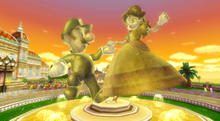
It has been stated that Luigi has a crush on Daisy, and the attraction appears to be mutual. In Daisy's second appearance in the Mario series, NES Open Tournament Golf, she served as Luigi's caddy, just as Peach was caddying for Mario, and as her trophy in Super Smash Bros. Melee points out, since that point "some gossips started portraying her as Luigi's answer to Mario's Peach". They are often paired up in spin-off games: they are seen golfing together in Mario Golf Toadstool Tour, are "buddy players" with good chemistry in the Mario Baseball series, they appear together in the Miracle Book pages from Mario Party 6, and in Mario Kart Wii, there is a giant, golden statue on the Daisy Circuit that shows the two holding hands and dancing together, along with another of Baby Luigi and Baby Daisy. Their team names from the Mario Party series include, "Steady Sweeties" and "Tango Tanglers", and when Daisy received her trophy from Luigi in Mario Power Tennis, she says, "Hey, sweetie! I'll take that".
Another one of Luigi's friendships can also be seen with Professor E. Gadd. Although the only interactions between them aren't frequent, they work very well together. E. Gadd shows much trust in Luigi, despite Luigi's cowardly nature. Throughout Luigi's Mansion: Dark Moon, E. Gadd jokingly holds Luigi in low regards, though he also states to be proud of him for courageously exploring the hostile ghost filled mansions as well as defeating the various Possessor ghosts. Luigi was also devastated to see E. Gadd trapped in a painting in Luigi's Mansion 3, showing that Luigi cares about his well-being, as well as understanding that E. Gadd can help him save the others.
Luigi is shown to get along with his Rabbid counterpart, because they are willing to cooperate in order to defeat the Megabug, and restore order to the Mushroom Kingdom. Group artwork for Mario + Rabbids Kingdom Battle shows the two characters posing together, while their in-game interactions are also friendly. Rabbid Luigi even possesses a few similarities to Luigi, such as being timid and polite in personality, as well as favoring long-ranged over close-quarter combat. In Mario & Sonic at London 2012 Olympic Games, Luigi is shown to be good friends with Miles "Tails" Prower, with them having a special victory animation in the sequels.
Enemies/Rivals
Though Bowser's main rivalry is with Mario, he views Luigi as almost a great a threat as his brother in games such as Super Mario Galaxy and its sequel. At other times, Bowser has trouble even remembering Luigi's name, particularly in the Mario & Luigi series where he often defaults to calling him "Green 'Stache" (although Bowser finally calls Luigi by his real name at the end of Mario & Luigi: Dream Team). Rather than Bowser, Luigi's arch-nemesis is actually King Boo, whom he met and defeated single-handedly in Luigi's Mansion when the ghost king kidnapped Mario. King Boo would later try to get revenge in Luigi's Mansion: Dark Moon and Luigi's Mansion 3, and the rivalry can be seen in other series as well, such as the Mario Baseball games, in which Luigi (along with Mario) shares bad chemistry with the Boo king, Super Mario 64 DS, where King Boo (known as Big Boo in the English version) was the one keeping the key locking Luigi away, and the Adventure Tour of Mario & Sonic at the Olympic Winter Games, where King Boo selects Luigi to face him in Polatraits due to the latter's fear of ghosts.
Another heated rivalry exists between Luigi and Waluigi, with the two sharing bad chemistry in all the games they appear in together, and acting hostile and rude towards each other, such as Luigi making a gesture at Waluigi to anger him in Mario Tennis, the two scowling at each other in the Mario Party 3 group picture, and Waluigi's vandalism of Luigi's picture in the opening movie of Mario Power Tennis. Waluigi is constantly seen harassing Luigi, whether by humiliating him during the sports competition, following him wherever he goes, or even directly confronting him. The origins of their animosity is unknown, however jealousy may be a factor, as both Luigi and Waluigi have a crush on Princess Daisy, who rejects Waluigi. Luigi himself, while he despises Waluigi, mostly prefers to ignore him and his antics.
Just as Luigi's interactions with Daisy and antagonism with King Boo nearly mirror his brother's with Peach and Bowser, respectively, his arch-rivalry with Waluigi parallels the one between Mario and Wario. Wario himself does not show as much antagonism towards Luigi as Waluigi, although the two do not get along well and it has been shown that Wario enjoys giving Luigi trouble, such as by tying his shoelaces together[25]. However, Luigi has rescued Wario from Chief Chilly in Super Mario 64 DS, indicating some degree of respect for the two.
In the first two installments of the Mario & Sonic series, Luigi shares a competitive, friendly rivalry with Shadow the Hedgehog in a similar way his brother is with Sonic the Hedgehog. They competed in Hurdles and raced in Skating races (the latter in which Metal Sonic outpaced them and the opening's epilogue shows them standing side-by-side afterwards).
Profiles and statistics
- Main article: List of Luigi profiles and statistics
Mario Tennis series
Mario Tennis
- Type: All-Around
- Instruction Booklet Bio: His height lets him hit even the balls that look like they're out of reach.
Mario Power Tennis
- Type: All-Around
- Offensive Power Shot: Squeaky Mallet
- Defensive Power Shot: Poltergust Return
- Stats:
- Power: 6/10
- Speed: 7/10
- Reach: 7/10
- Serve: 6/10
- Lunge: 7/10
- Control: 7/10
- Doubles Partner: Mario
- Bio: Luigi has better ball control than his famous sibling and is especially skilled at volleying.
Mario Tennis Open
- Type: All-Around
- Bio: Compared to Mario, he is a bit less powerful, but Luigi is good at ball handling. His specialty is playing up front, at the net.
- Bio 2: Like his brother, Luigi is pretty good at everything. Although not as powerful as Mario, he has greater accuracy and is excellent at coming into the net.
Portrayals
A list of all of the people who have portrayed Luigi.
- Yū Mizushima - Super Mario Bros.: Peach-hime Kyushutsu Dai Sakusen!, Super Mario World: Mario to Yoshi no Bōken Land
- Charles Martinet - Mario in Real Time, Mario Kart 64 (overseas version only), and all other media
- Bob Sorenson - Mario is Missing!
- Marc Graue - Hotel Mario
- Danny Wells - The Super Mario Bros. Super Show!
- Tony Rosato - The Adventures of Super Mario Bros. 3, Super Mario World
- Julien Bardakoff - Mario Kart 64 (Japanese version only), Mario Party, Mario Party 2, Mario Kart: Super Circuit
Gallery
- For this subject's image gallery, see Gallery:Luigi.
- Luigi Mario Bros.png
- TanookiLuigi.png
Quotes
- Main article: List of Luigi quotes
- "Oh, yeah!" - Various games
- "Okey dokey!" - Various games
- "Let's-a go!" - Various games
- "Yay for me!" - Mario Party 9
- "I'm-a Luigi, number one!" - Mario Kart 64
- "Hello...?" - Luigi's Mansion / Luigi's Mansion: Dark Moon
- "Come here, doggy." - Luigi's Mansion: Dark Moon
- "MARIO!!!" - Luigi's Mansion / Luigi's Mansion: Dark Moon
- "You wanna switch, bro?" - Super Mario Galaxy 2
- "Oh yeah, who's number one now? Luigi!" - Mario Kart: Double Dash!!
- "Oh, this look bad." - Mario Power Tennis
- "Thanks, bro!" - Super Mario 3D Land
- "Hey! You know what would look good? A spaceship with MY face on it!" - Fortune Street
- "Yes! Luigi won!" - Mario Party 8
- "Whew! Made it!" - New Super Mario Bros. Wii / New Super Mario Bros. 2 / New Super Mario Bros. U / New Super Luigi U / Super Mario Run
- "Oh, what happened?" - Mario Kart 8 / Mario Kart 8 Deluxe
- "Ha ha ha! I'm the best!" - Mario Party 4 / Mario Party 5
See also
Names in other languages
| Language | Name | Meaning | Notes |
|---|---|---|---|
| Japanese | ルイージ[?] Ruīji |
Luigi | |
| Chinese | 路易吉 Lùyìjí[?] |
Luigi | |
| Dutch | Luigi[?] | - | |
| German | Luigi[?] | - | |
| Greek | Λουίτζι[?] Luitzi |
- | |
| Hebrew | לואיג'י[?] Luigi |
- | |
| Italian | Luigi[?] | - | |
| Korean | 루이지[?] Ruiji |
Luigi | |
| Portuguese | Luigi[?] | - | |
| Russian | Луиджи[?] Luidzhi |
Luigi | |
| Spanish | Luigi[?] | - |
Trivia
- Although his first formal appearance was in Mario Bros., the intro to the Donkey Kong Jr. arcade game featured a man similar to Mario who may have been the basis for Luigi.
- Coincidentally, "Luigi" translates to Italian as "famous warrior," which is ironic or apt given the circumstance. Luigi is often portrayed as being the "lesser brother" and he is presented as a coward in some events, although he is an iconic video game hero as well.
- The Japanese pronunciation of Luigi, "Ruīji"(ルイージ) also alludes to a Japanese word for similar (類似 ルイジ "Ruiji") which is almost pronounced in the exact same way, save for a shorter "i." It is unknown if this was intentional as Luigi was originally created as a color swap.
- In the first page of the Nintendo Power magazine for Luigi's Mansion, Luigi is accidentally called Mario's "older brother." This probably an error, as Luigi is known as the younger brother.
- Luigi is also a playable character in Monopoly Gamer. He is sold separately as a "Power Pack" expansion figure.
References
- ^ The Mushroom Kingdom (Accessed on 7-2-09)
- ^ a b c McLaughlin, Rus (November 8, 2007). IGN Presents The History of Super Mario Bros. IGN. (Accessed on 6-28-09)
- ^ The International Arcade Museum (Accessed on 7-2-08)
- ^ Mario Bros. - Videogame by Nintendo. The International Arcade Museum at Museum of the Game. Retrieved July 27, 2015.
- ^ News article covering interview with Shigeru Miyamoto. Retrieved January 24, 2015.
- ^ a b Commercial for Atari Mario Bros. featuring a live-action Luigi.
- ^ Print ad for Mario Bros.
- ^ "We all know Mario who saved the beautiful girl from Donkey Kong. Now he's back with his brother Luigi, working in a bottling plant, loading cases on a conveyor belt. The conveyor carries the cases up for loading onto trucks." - Mario Bros. Game & Watch manual, page 4
- ^ "The left button moves Luigi up and down to carry cases to the next higher conveyor." -Mario Bros. Game & Watch manual, page 8
- ^ http://iwataasks.nintendo.com/interviews/#/wiiu/super-mario-3d-world/0/6
- ^ https://www.youtube.com/watch?v=CBdQUWl7JeI
- ^ https://www.youtube.com/watch?v=rKG5jU6DV70
- ^ https://miiverse.nintendo.net/posts/AYMHAAACAADMUKlpzooN0A
- ^ Smash Bros. Blog (09: Luigi)
- ^ GameXplain (May 14, 2020). 42 NEW Paper Mario: The Origami King Screenshots (LUIGI'S GOT HIS KART BACK, BABY). YouTube. Retrieved May 14, 2020.
- ^ https://www.nintendo.co.uk/Games/Nintendo-Switch/Paper-Mario-The-Origami-King-1782440.html#Story
- ^ http://www.youtube.com/watch?v=A_HDOXAMnZo
- ^ a b Rolling Stone (April 8, 2013). Shigeru Miyamoto Shares Nintendo Secrets. Rolling Stone. Retrieved May 13, 2018
- ^ [1]
- ^ IGN (Accessed on 7-6-09)
- ^ N-Sider (Accessed on 6-28-09)
- ^ a b Smash Bros. DOJO!! (Accessed on 6-28-09)
- ^ The Yoshi Touch & Go instruction booklet states that the Stork is carrying a pair of newborn twins (referring to Mario and Luigi) on page six.
- ^ The Super Mario Kart manual (page 21) states that "Mario and Luigi have had a friendly rivalry that goes back to their childhood."
- ^ Wario Land 4 official website (now defunct) (Accessed on 7-3-09)
- Humans
- Twins
- Plumbers
- Magicians
- Police
- Shopkeepers
- Captains
- Pirates
- Doctors
- Playable Characters
- Unlockable Characters
- Allies
- Amiibo tap: Nintendo's Greatest Bits
- Brain Drain Characters
- Dance Dance Revolution: Mario Mix Characters
- Dinosaur Dilemma Characters
- Double Trouble Characters
- Dr. Luigi
- Dr. Mario: Miracle Cure
- Dr. Mario World
- Fortune Street Characters
- Heads-Up
- Hotel Mario
- Itadaki Street DS Characters
- Leaping Lizards Characters
- Luigi's Mansion
- Luigi's Mansion 3
- Luigi's Mansion: Dark Moon
- Mario + Rabbids Kingdom Battle Characters
- Mario & Luigi: Bowser's Inside Story Characters
- Mario & Luigi: Bowser's Inside Story + Bowser Jr.'s Journey Characters
- Mario & Luigi: Dream Team Characters
- Mario & Luigi: Paper Jam Characters
- Mario & Luigi: Partners in Time Characters
- Mario & Luigi: Superstar Saga Characters
- Mario & Luigi: Superstar Saga + Bowser's Minions Characters
- Mario & Sonic at the London 2012 Olympic Games Characters
- Mario & Sonic at the Olympic Games Characters
- Mario & Sonic at the Olympic Games Tokyo 2020
- Mario & Sonic at the Olympic Winter Games Characters
- Mario & Sonic at the Rio 2016 Olympic Games Characters
- Mario & Sonic at the Sochi 2014 Olympic Winter Games Characters
- Mario & Wario
- Mario Bros.
- Mario Clash
- Mario Golf 64 Characters
- Mario Golf GBC Characters
- Mario Golf: Advance Tour Characters
- Mario Golf: Toadstool Tour Characters
- Mario Golf: World Tour Characters
- Mario Hoops 3-on-3 Playable Characters
- Mario is Missing! Characters
- Mario Kart 64 Characters
- Mario Kart 7 Characters
- Mario Kart 8 Characters
- Mario Kart 8 Deluxe Characters
- Mario Kart Arcade GP Characters
- Mario Kart Arcade GP 2 Characters
- Mario Kart Arcade GP DX Characters
- Mario Kart Arcade GP VR
- Mario Kart: Double Dash!! Characters
- Mario Kart DS Characters
- Mario Kart Tour Characters
- Mario Kart: Super Circuit Characters
- Mario Kart Wii Characters
- Mario Kart Wii Trading Cards
- Mario Party Characters
- Mario Party 2 Characters
- Mario Party 3 Characters
- Mario Party 4 Characters
- Mario Party 5 Characters
- Mario Party 6 Characters
- Mario Party 7 Characters
- Mario Party 8 Characters
- Mario Party 9 Characters
- Mario Party 10 Characters
- Mario Party Advance Characters
- Mario Party DS Characters
- Mario Party-e Characters
- Mario Party: Island Tour Characters
- Mario Party: Star Rush Characters
- Mario Party: The Top 100 Characters
- Mario Power Tennis Characters
- Mario Sports Mix Characters
- Mario Sports Superstars Characters
- Mario Strikers Charged Characters
- Mario Super Sluggers Playable Characters
- Mario Superstar Baseball Characters
- Mario Tennis 64 Characters
- Mario Tennis Aces Characters
- Mario Tennis GBC Characters
- Mario Tennis Open Characters
- Mario Tennis: Power Tour Characters
- Mario Tennis: Ultra Smash Characters
- Mario's Tennis Characters
- Mario's Time Machine Characters
- Monster Mix-Up Characters
- NES Open Tournament Golf Characters
- NES Remix
- NES Remix 2
- New Super Luigi U
- New Super Mario Bros. Characters
- New Super Mario Bros. 2 Characters
- New Super Mario Bros. U Characters
- New Super Mario Bros. Wii Characters
- New Super Mario Bros. Wii Trading Cards
- Paper Mario Characters
- Paper Mario: Color Splash Characters
- Paper Mario: Sticker Star Characters
- Paper Mario: The Origami King Characters
- Paper Mario: The Thousand-Year Door Characters
- Paper Mario Series Party Members
- Pipe Down! Characters
- Puzzle & Dragons: Super Mario Bros. Edition
- Super Mario 3D Land Characters
- Super Mario 3D World Characters
- Super Mario 64 Characters
- Super Mario Advance 4: Super Mario Bros. 3
- Super Mario amiibo Line
- Super Mario Bros.
- Super Mario Bros. 2
- Super Mario Bros. 3
- Super Mario Bros. Deluxe
- Super Mario Bros.: The Lost Levels
- Super Mario Galaxy Characters
- Super Mario Galaxy 2 Characters
- Super Mario Galaxy Trading Cards
- Super Mario Kart Characters
- Super Mario Maker Costumes
- Super Mario Maker 2
- Super Mario Odyssey Characters
- Super Mario RPG: Legend of the Seven Stars Characters
- Super Mario Run Characters
- Super Mario Strikers Characters
- Super Mario World Characters
- Super Mario World (television series)
- Super Paper Mario Bosses
- Super Paper Mario Characters
- Super Princess Peach
- Super Smash Bros. amiibo Line
- Super Smash Bros. Fighters
- Super Smash Bros. Brawl Fighters
- Super Smash Bros. Brawl Stickers
- Super Smash Bros. Brawl Trophies
- Super Smash Bros. for Nintendo 3DS / Wii U Fighters
- Super Smash Bros. for Nintendo 3DS Trophies
- Super Smash Bros. for Wii U Trophies
- Super Smash Bros. Melee Fighters
- Super Smash Bros. Melee Trophies
- Super Smash Bros. Ultimate Fighters
- Super Smash Bros. Ultimate Spirits
- The Adventures of Super Mario Bros. 3 Characters
- The Super Mario Bros. Super Show! Characters
- Unjust Desserts Characters
- UNO Super Mario
- Wrecking Crew
- Wrecking Crew '98
- Yakuman DS
- Yoshi (game)

